-
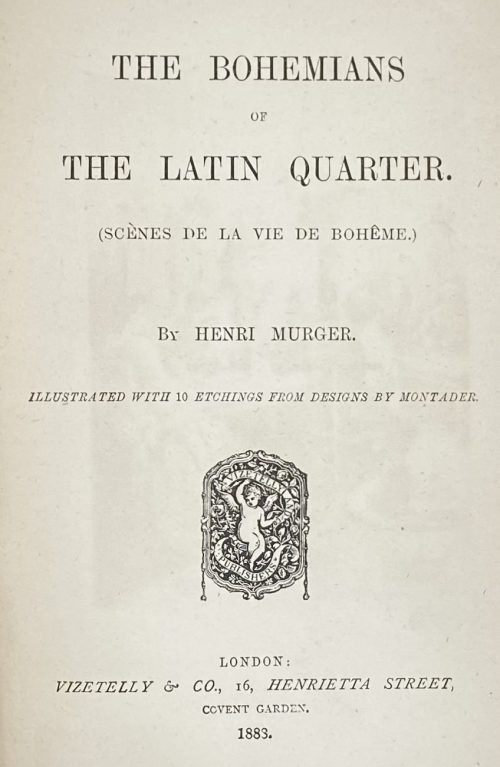 Title: THE BOHEMIANS | OF | THE LATIN QUARTER. | (SCÈNES DE LA VIE DE BOHÊME.) | By HENRI MURGER. | ILLUSTRATED WITH 10 ETCHINGS FROM DESIGNS BY MONTADER. |{publisher’s device}| LONDON: | VIZETELLY & CO., 16, HENRIETTA STREET, | COVENT GARDEN. | 1888. || Pagination: [i-v] vi-xxxiv, [1] 2-317 [318 blank]; collation: 8vo, π1 (h.t.), [a]-b8, B-U8 X7 + 10 etchings by Charles Courtry after Alfred Montader (incl. frontispiece and portrait of Henri Murger). Binding: 23 x 14.5 cm, olive cloth, black lettering to cover and gilt lettering to spine. Contributors: Murger, Henri [Henry] (French, 1822 – 1861) – original text (French). Montader, Pierre Marie Alfred (French, fl. c. 1881 – 1925) – artist. Courtry, Charles Jean Louis (French, 1846 – 1897) – engraver. Vizetelly, Henry Richard (British, 1820 – 1894) – publisher.
Title: THE BOHEMIANS | OF | THE LATIN QUARTER. | (SCÈNES DE LA VIE DE BOHÊME.) | By HENRI MURGER. | ILLUSTRATED WITH 10 ETCHINGS FROM DESIGNS BY MONTADER. |{publisher’s device}| LONDON: | VIZETELLY & CO., 16, HENRIETTA STREET, | COVENT GARDEN. | 1888. || Pagination: [i-v] vi-xxxiv, [1] 2-317 [318 blank]; collation: 8vo, π1 (h.t.), [a]-b8, B-U8 X7 + 10 etchings by Charles Courtry after Alfred Montader (incl. frontispiece and portrait of Henri Murger). Binding: 23 x 14.5 cm, olive cloth, black lettering to cover and gilt lettering to spine. Contributors: Murger, Henri [Henry] (French, 1822 – 1861) – original text (French). Montader, Pierre Marie Alfred (French, fl. c. 1881 – 1925) – artist. Courtry, Charles Jean Louis (French, 1846 – 1897) – engraver. Vizetelly, Henry Richard (British, 1820 – 1894) – publisher. -
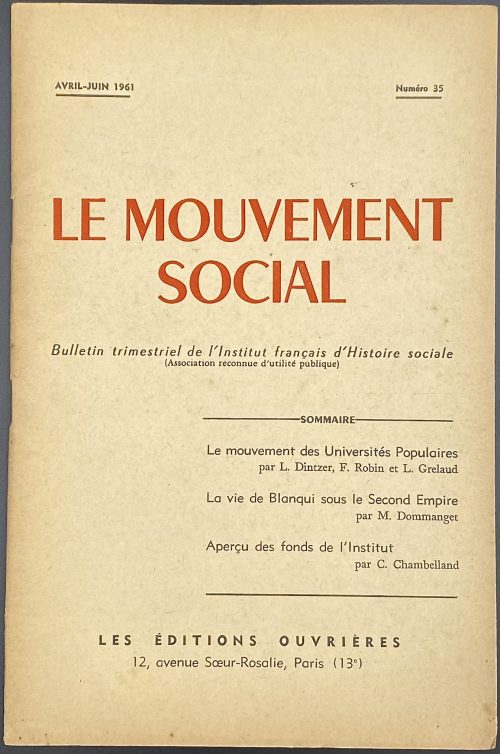 Front wrapper and title page : AVRIL – JUIN 1961 […] Numéro 35 |LE MOUVEMENT SOCIAL | Bulletin trimestriel de l'Institut français d'Histoire sociale | (Association reconnue d’utilité publique) | Le mouvement des Universités Populaires | par L. Dintzer, F. Robin et L. Grelaud | La vie de Blanqui sous le second empire | par M. Dommanget | Aperçu des fonds de l'Institut | par C. Chambelland | LES ÉDITIONS OUVRIÈRES | 12 avenue Sœur-Rosalie, Paris (13e) || Pagination : [1, 2] 3-48. Publisher’s wrappers, 24 x 16 cm. The paper by Maurice Dommanget (French, 1888 – 1976) La vie de Blanqui sous le Second Empire : de la sortie de Belle-ile à la sortie de Sainte-Pélagie (1er décembre 1857 – 12 mars 1864), pp. 30–41.
Front wrapper and title page : AVRIL – JUIN 1961 […] Numéro 35 |LE MOUVEMENT SOCIAL | Bulletin trimestriel de l'Institut français d'Histoire sociale | (Association reconnue d’utilité publique) | Le mouvement des Universités Populaires | par L. Dintzer, F. Robin et L. Grelaud | La vie de Blanqui sous le second empire | par M. Dommanget | Aperçu des fonds de l'Institut | par C. Chambelland | LES ÉDITIONS OUVRIÈRES | 12 avenue Sœur-Rosalie, Paris (13e) || Pagination : [1, 2] 3-48. Publisher’s wrappers, 24 x 16 cm. The paper by Maurice Dommanget (French, 1888 – 1976) La vie de Blanqui sous le Second Empire : de la sortie de Belle-ile à la sortie de Sainte-Pélagie (1er décembre 1857 – 12 mars 1864), pp. 30–41. -
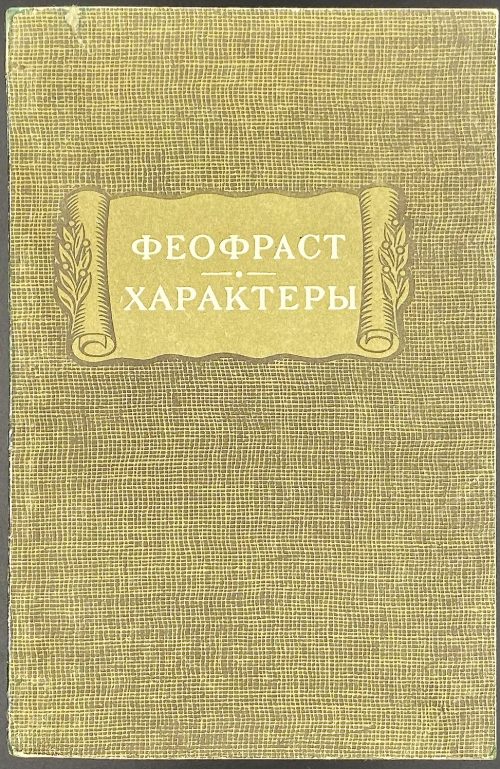 Half-title: АКАДЕМИЯ НАУК СССР | Литературные памятники | {serial device} || Title page: ФЕОФРАСТ | ХАРАКТЕРЫ | ПЕРЕВОД, СТАТЬЯ И ПРИМЕЧАНИЯ | Г. А. CТРАТАНОВСКОГО | ИЗДАТЕЛЬСТВО «НАУКА» | Ленинградское отделение | Ленинград | 1974 || Frontispiece: ΘΕΟΦΡΑΣΤΟΥ | ΧΑΡΑΚΤΗΡΕΣ Pagination: [1-5] 6- 123 [124]. Collation: 8vo; [1]-68, 76, 88 (total 62 leaves); signed ¼7, ½7. Binding: publisher’s serial green wrappers, lettering on a scroll. Contributors: Theophrastus [Θεόφραστος, Theόphrastos, Теофраст, Феофраст] (Greek, c. 371 – c. 287 BC) – author. Стратановский, Георгий Андреевич (Russian, 1901 – 1986) – translator.
Half-title: АКАДЕМИЯ НАУК СССР | Литературные памятники | {serial device} || Title page: ФЕОФРАСТ | ХАРАКТЕРЫ | ПЕРЕВОД, СТАТЬЯ И ПРИМЕЧАНИЯ | Г. А. CТРАТАНОВСКОГО | ИЗДАТЕЛЬСТВО «НАУКА» | Ленинградское отделение | Ленинград | 1974 || Frontispiece: ΘΕΟΦΡΑΣΤΟΥ | ΧΑΡΑΚΤΗΡΕΣ Pagination: [1-5] 6- 123 [124]. Collation: 8vo; [1]-68, 76, 88 (total 62 leaves); signed ¼7, ½7. Binding: publisher’s serial green wrappers, lettering on a scroll. Contributors: Theophrastus [Θεόφραστος, Theόphrastos, Теофраст, Феофраст] (Greek, c. 371 – c. 287 BC) – author. Стратановский, Георгий Андреевич (Russian, 1901 – 1986) – translator. -
 Iron tsuba of round form, tapering from centre to the rim, decorated with eight roundels – circular emblems of flowers and/or family crests (mon) made of cast brass, pierced and chiselled in kebori, and with flat brass inlay (hira-zōgan) of water plantain (omodaka) and seaweed all over the plate. Hitsu-ana outlined in brass. Four positive silhouette roundels are 3-, 6-, 9-, and 12 – pointing crests/flowers; four negative silhouette roundels – bellflower, cherry and plum blossoms. Yoshirō school (Kaga-Yoshirō). Unsigned. The Momoyama or early Edo period, end of the 16th to the first half of the 17th century (1574-1650). Size: H: 88.3 mm; W: 88.7 mm; Thickness 4.0 mm (Seppa-dai), 3,2 cm (rim). Other Kaga-Yoshiro tsuba in this collection: TSU-0334: 7.7 cm; TSU-0342.2017: 89.6 cm; TSU-0344: 8.1 cm; TSU-0329: 8.0 cm; TSU-0376.2018: 8.1 cm; TSU-0379.2018: 8.2 cm. We see that the usual size is about 8 cm; larger pieces, such as this one and TSU-0342.2017 dedicated to Hachiman, are rare. Article about Yoshiro tsuba.
Iron tsuba of round form, tapering from centre to the rim, decorated with eight roundels – circular emblems of flowers and/or family crests (mon) made of cast brass, pierced and chiselled in kebori, and with flat brass inlay (hira-zōgan) of water plantain (omodaka) and seaweed all over the plate. Hitsu-ana outlined in brass. Four positive silhouette roundels are 3-, 6-, 9-, and 12 – pointing crests/flowers; four negative silhouette roundels – bellflower, cherry and plum blossoms. Yoshirō school (Kaga-Yoshirō). Unsigned. The Momoyama or early Edo period, end of the 16th to the first half of the 17th century (1574-1650). Size: H: 88.3 mm; W: 88.7 mm; Thickness 4.0 mm (Seppa-dai), 3,2 cm (rim). Other Kaga-Yoshiro tsuba in this collection: TSU-0334: 7.7 cm; TSU-0342.2017: 89.6 cm; TSU-0344: 8.1 cm; TSU-0329: 8.0 cm; TSU-0376.2018: 8.1 cm; TSU-0379.2018: 8.2 cm. We see that the usual size is about 8 cm; larger pieces, such as this one and TSU-0342.2017 dedicated to Hachiman, are rare. Article about Yoshiro tsuba. -
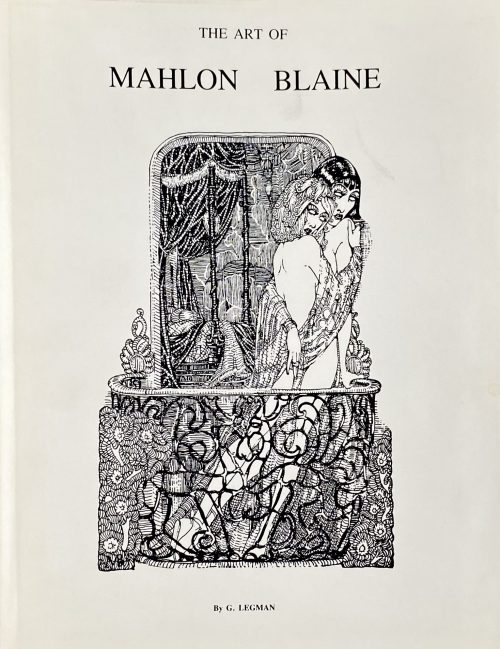 Title page: THE ART OF | MAHLON BLAINE | A Reminiscence | by G. Legman | with a Mahlon Blaine bibliography | compiled by Roland Trenary | {Blaine’s fac-simile} | Peregrine Books | 1982 || Pagination: [1-4] 5-26 + 84 pp. of illustrations, unpaginated. Collation: 13 leaves of text, 40 leaves of b/w plates, and 2 leaves of colour plates, 55 leaves total. Binding: 29 x 22.5 cm; publisher’s black cloth, silver lettering to spine, pictorial endpapers, pictorial dust jacket. Edition: Limited edition of 100 copies (this is №100), signed by Gelman, Trenary, and Arrington. Contributors: Blaine, Mahlon (American, 1894 – 1969) – illustrator. Legman, Gershon (American, 1917 – 1999) – author. Arrington, Robert L. (American, 1984 – 2015) – author, introduction. Trenary, Roland (American) – author, compiler. Peregrine Books (East Lansing, MI) – publisher.
Title page: THE ART OF | MAHLON BLAINE | A Reminiscence | by G. Legman | with a Mahlon Blaine bibliography | compiled by Roland Trenary | {Blaine’s fac-simile} | Peregrine Books | 1982 || Pagination: [1-4] 5-26 + 84 pp. of illustrations, unpaginated. Collation: 13 leaves of text, 40 leaves of b/w plates, and 2 leaves of colour plates, 55 leaves total. Binding: 29 x 22.5 cm; publisher’s black cloth, silver lettering to spine, pictorial endpapers, pictorial dust jacket. Edition: Limited edition of 100 copies (this is №100), signed by Gelman, Trenary, and Arrington. Contributors: Blaine, Mahlon (American, 1894 – 1969) – illustrator. Legman, Gershon (American, 1917 – 1999) – author. Arrington, Robert L. (American, 1984 – 2015) – author, introduction. Trenary, Roland (American) – author, compiler. Peregrine Books (East Lansing, MI) – publisher. -
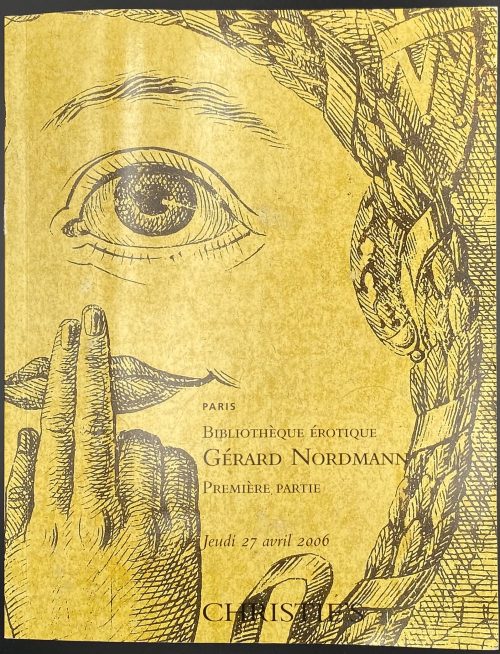 Publisher’s yellow pictorial wrappers with lettering: PARIS | Bibliothèque érotique | Gérard Nordmann | Première partie | Jeudy 27 avril 2006 | CHRISTIE'S || Red spine with white lettering from top to bottom, multiple illustrations in colour, 27 x 21 cm. Pagination: [1-3] 4-295, 431 lots. Loose inset of 4 pages with prices realized. The 1st part of the auction of the library of Gérard Nordmann (Swiss, 1930 – 1992), held by Christie's in Paris on the 27th of April 2006. The 2nd part took place on the 14th and 15th of December 2006, see [LIB-2810.2021].
Publisher’s yellow pictorial wrappers with lettering: PARIS | Bibliothèque érotique | Gérard Nordmann | Première partie | Jeudy 27 avril 2006 | CHRISTIE'S || Red spine with white lettering from top to bottom, multiple illustrations in colour, 27 x 21 cm. Pagination: [1-3] 4-295, 431 lots. Loose inset of 4 pages with prices realized. The 1st part of the auction of the library of Gérard Nordmann (Swiss, 1930 – 1992), held by Christie's in Paris on the 27th of April 2006. The 2nd part took place on the 14th and 15th of December 2006, see [LIB-2810.2021]. -
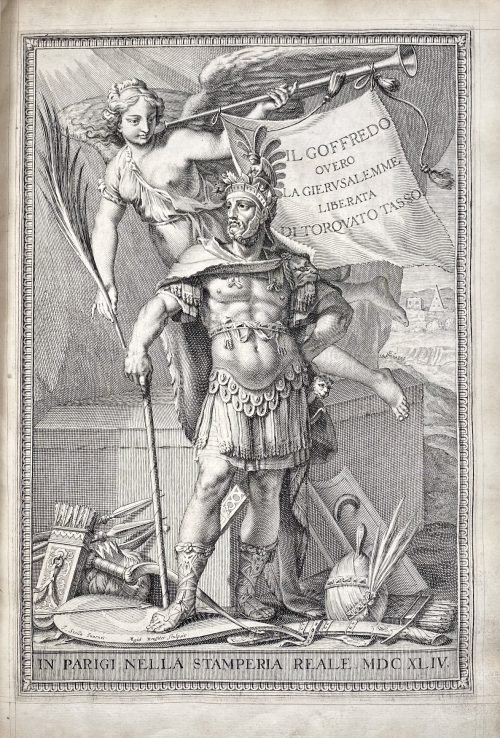 Title page: IL | GOFFREDO | OVERO | LA | GIERUSALEMME | LIBERATA | DI TORQUATO TASSO. || Engraved title: On the banner: IL GOFFREDO | OVERO | LA GIERUSALEMME | LIBERATA | DI TORQUATO TASSO ||; under the image, within frame: IN PARIGI NELLA STAMPERIA REALE MDC XLIV. Signed: J. Stella Invenit — Ægid Rousselet Sculpsit (with tall “s”) || Collation: 2 blank leaves with donation ink inscription to recto of the 1st: “Ex Dono Patruelis Do Roberto Willughby” [i.e. Robert Willoughby]; t.p. / blank, engraved t.p. by Gilles Rousselet after Jacques Stella / blank, “Allegoria dell poema” 4 leaves, 1st two leaves signed iij and iiij, respectively; π6 A-Z4 Aa-Zz4 Aaa-Rrr4, 2 blank leaves at the end; text paginated from 1 to 502 [2] (p. 503 tailpiece, p. 504 blank); a printable area marked with vertical and horizontal double lines; total: 252 leaves of text (504 pages), 6 prelims and 4 blanks. Illustrated throughout with head- and tailpieces, and historiated initials. Binding: 18th-century red crushed morocco, triple-fillet gilt border, triple-fillet gilt frame, panel with gilt lozenge centrepiece, lozenges at corners, marbled endpapers, AEG, crudely rebacked retaining original spine with raised bands, gilt in compartments, crimson label with gilt lettering; The Robin Collection bookplate to front pastedown. Provenance: The Robin Collection; Robert Willoughby family. Contributors: Torquato Tasso (Italian, 1544 –1595) – author. Jacques Stella (French, 1596 – 1657) – artist. Gilles [Aegidius] Rousselet (French, 1610 – 1686) – engraver.
Title page: IL | GOFFREDO | OVERO | LA | GIERUSALEMME | LIBERATA | DI TORQUATO TASSO. || Engraved title: On the banner: IL GOFFREDO | OVERO | LA GIERUSALEMME | LIBERATA | DI TORQUATO TASSO ||; under the image, within frame: IN PARIGI NELLA STAMPERIA REALE MDC XLIV. Signed: J. Stella Invenit — Ægid Rousselet Sculpsit (with tall “s”) || Collation: 2 blank leaves with donation ink inscription to recto of the 1st: “Ex Dono Patruelis Do Roberto Willughby” [i.e. Robert Willoughby]; t.p. / blank, engraved t.p. by Gilles Rousselet after Jacques Stella / blank, “Allegoria dell poema” 4 leaves, 1st two leaves signed iij and iiij, respectively; π6 A-Z4 Aa-Zz4 Aaa-Rrr4, 2 blank leaves at the end; text paginated from 1 to 502 [2] (p. 503 tailpiece, p. 504 blank); a printable area marked with vertical and horizontal double lines; total: 252 leaves of text (504 pages), 6 prelims and 4 blanks. Illustrated throughout with head- and tailpieces, and historiated initials. Binding: 18th-century red crushed morocco, triple-fillet gilt border, triple-fillet gilt frame, panel with gilt lozenge centrepiece, lozenges at corners, marbled endpapers, AEG, crudely rebacked retaining original spine with raised bands, gilt in compartments, crimson label with gilt lettering; The Robin Collection bookplate to front pastedown. Provenance: The Robin Collection; Robert Willoughby family. Contributors: Torquato Tasso (Italian, 1544 –1595) – author. Jacques Stella (French, 1596 – 1657) – artist. Gilles [Aegidius] Rousselet (French, 1610 – 1686) – engraver. -
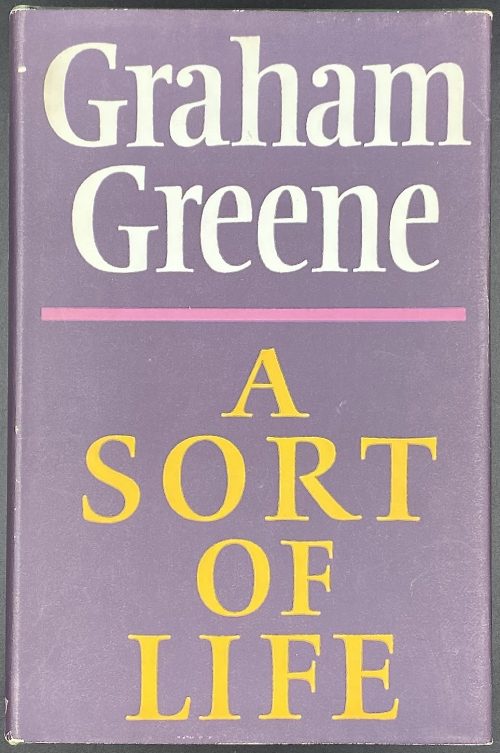 Title-page: A SORT OF LIFE | — | Graham Greene | — | {publisher’s device} | THE BODLEY HEAD | LONDON SYDNEY | TORONTO || Green publisher’s cloth with silver lettering to spine, aubergine dust jacket, lettered on front and spine, designed by Michael Harvey, unclipped (£1.80 NET | IN U.K. ONLY), [1-8] 9-215 [216] + 2 blank leaves. © Graham Greene 1971. Printed by: William Clowes & Sons Ltd. (Beccles). Graham Greene (British, 1904 – 1991).
Title-page: A SORT OF LIFE | — | Graham Greene | — | {publisher’s device} | THE BODLEY HEAD | LONDON SYDNEY | TORONTO || Green publisher’s cloth with silver lettering to spine, aubergine dust jacket, lettered on front and spine, designed by Michael Harvey, unclipped (£1.80 NET | IN U.K. ONLY), [1-8] 9-215 [216] + 2 blank leaves. © Graham Greene 1971. Printed by: William Clowes & Sons Ltd. (Beccles). Graham Greene (British, 1904 – 1991). -
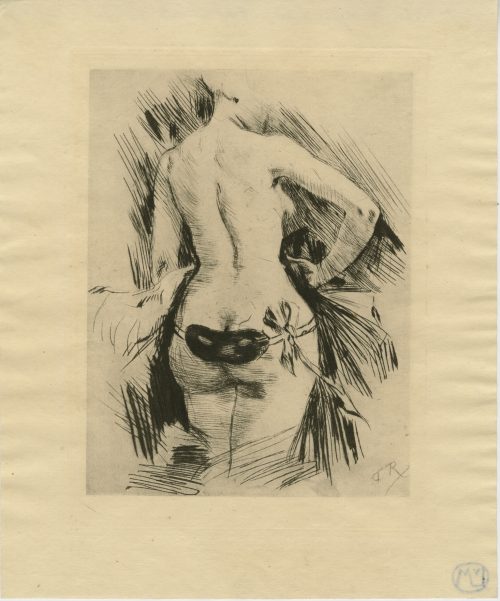
Etching and drypoint on wove paper, depicting a woman with a face mask on her buttocks. Monogrammed in the plate 'FR'. Owner's stamp 'LvM' on verso.
Dimensions: Papaer: 22.2 x 18.5 cm; Plate: 17.5 x 13.3 cm; Image: 15.5 x 12 cm.
Catalogue raisonné: Arthur Hubschmid (1977): 448; Graphics irreverent and erotic (1968): 106; Rouir 648.
-
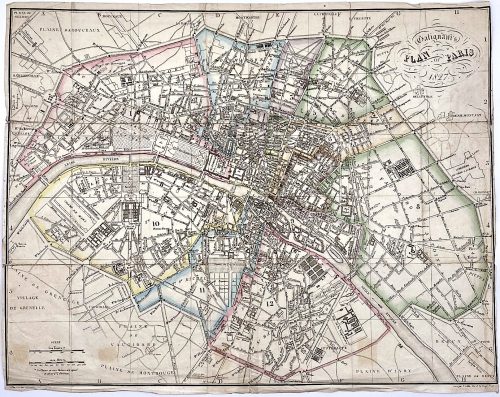 Upper right: Galignani's | PLAN OF PARIS | 1827 || in oval frame: Sauve sculpt. Bottom, under the frame: le Plan écrit par Lallemand. […] Gravé par E. Collin. Rue de la Harpe № 45. Dimensions: 36.5 x 46.5 cm. Armand Joseph Lallemand (French, c. 1810 - 1871) – cartographer. Charles-Étienne Collin (French, 1770 – 1840) – engraver. Étienne Collin II (French,1790 – 1852) – engraver. John Anthony Galignani (Italian, 1796 – 1873) – publisher. William Galignani (Italian, 1798 – 1882) – publisher.
Upper right: Galignani's | PLAN OF PARIS | 1827 || in oval frame: Sauve sculpt. Bottom, under the frame: le Plan écrit par Lallemand. […] Gravé par E. Collin. Rue de la Harpe № 45. Dimensions: 36.5 x 46.5 cm. Armand Joseph Lallemand (French, c. 1810 - 1871) – cartographer. Charles-Étienne Collin (French, 1770 – 1840) – engraver. Étienne Collin II (French,1790 – 1852) – engraver. John Anthony Galignani (Italian, 1796 – 1873) – publisher. William Galignani (Italian, 1798 – 1882) – publisher. -
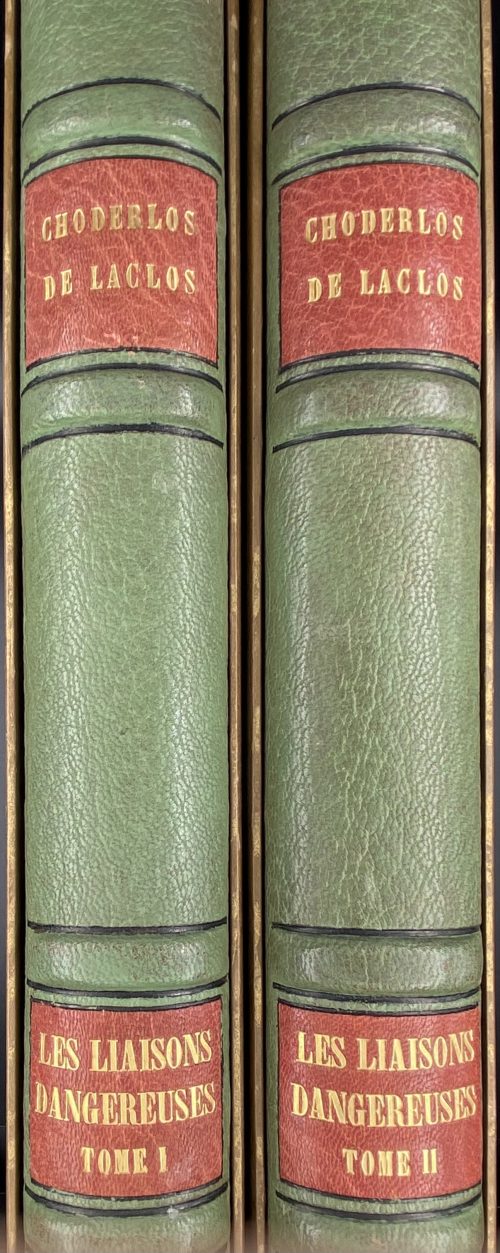 Description: Two volumes 34 x 26.5 cm each, each in a green/gilt marbled in a slipcase, bound in green morocco, spine with raised bands and two gilt-lettered brown labels, original wrappers bound in, marbled endpapers; printed on Montval watermarked wove paper, top margin gilt, outer and bottom margins untrimmed. Front wrapper (in oval red frame): CH. De LACLOS | LES | LIAISONS | DANGEREUSES | {fleuron} | TOME PREMIER (TOME SECOND) | — | CHEZ SYLVAIN SAUVAGE | 16 RUE CASSINI A PARIS | ANNO DOMINI | MCMXXX || Title-page (black and red): ~ CHODERLOS DE LACLOS ~ | LES | LIAISONS | DANGEREUSES | OU | LETTRES | RECUEILLIES DANS UNE SOCIETE ET | PUBLIEES POUR L’INSTRUCTION | DE QUELQUES AUTRES | {vignette} | TOME PREMIER (TOME SECOND) | AVEC DES FIGURES DE S. SAUVAGE | GRAVEES SUR CUIVRE AVEC LA COLLABORATION DE D.A.MAILLART | A PARIS EN L’AN GRACE | MCMXXX || Vol. 1: Collation: 2 blanks, 1 front wrapper, 1 blank/limitation, 1 h.t./frontis., 1 t.p., 3 advert., 1 d.t.p. première partie, 106 leaves, 1 blank, 1 back wrapper, 1 blank/spine, 1 blank; total within wrappers 114 leaves with woodcut fleurons and tailpieces, and 23 engraved and coloured plates, incl. frontispiece, full-page and in-text, some with tissue guards. Pagination: [14] [1] 2-211 [212] [2], ils. Vol. 2: 2 blanks, 1 front wrapper, 1 blank, 1 h.t./frontis., 1 t.p., 1 d.t.p., 109 leaves, 1 plate, 1 colophon, 1 back wrapper, 1 blank/spine, 1 blank; total within wrappers 115 leaves, with woodcut fleurons and tailpieces, and 25 engraved plates, engraved and coloured plates, incl. frontispiece, full-page and in-text, some with tissue guards. Pagination: [8] [1] 2-218 [4], ils. Limitation: Printed on September 29, 1930, 165 copies (1-165), the first four enriched with a suite of b/w plates and one original drawing; 10 copies for collaborators marked I-X. This is copy № 129. Contributors: Choderlos de Laclos, Pierre Ambroise François (French, 1741 – 1803) – author. Sylvain Sauvage [Félix Roy] (French, 1888 – 1948) – artist, publisher. Pierre Bouchet (text), Paul Haasen (plates) – printers.
Description: Two volumes 34 x 26.5 cm each, each in a green/gilt marbled in a slipcase, bound in green morocco, spine with raised bands and two gilt-lettered brown labels, original wrappers bound in, marbled endpapers; printed on Montval watermarked wove paper, top margin gilt, outer and bottom margins untrimmed. Front wrapper (in oval red frame): CH. De LACLOS | LES | LIAISONS | DANGEREUSES | {fleuron} | TOME PREMIER (TOME SECOND) | — | CHEZ SYLVAIN SAUVAGE | 16 RUE CASSINI A PARIS | ANNO DOMINI | MCMXXX || Title-page (black and red): ~ CHODERLOS DE LACLOS ~ | LES | LIAISONS | DANGEREUSES | OU | LETTRES | RECUEILLIES DANS UNE SOCIETE ET | PUBLIEES POUR L’INSTRUCTION | DE QUELQUES AUTRES | {vignette} | TOME PREMIER (TOME SECOND) | AVEC DES FIGURES DE S. SAUVAGE | GRAVEES SUR CUIVRE AVEC LA COLLABORATION DE D.A.MAILLART | A PARIS EN L’AN GRACE | MCMXXX || Vol. 1: Collation: 2 blanks, 1 front wrapper, 1 blank/limitation, 1 h.t./frontis., 1 t.p., 3 advert., 1 d.t.p. première partie, 106 leaves, 1 blank, 1 back wrapper, 1 blank/spine, 1 blank; total within wrappers 114 leaves with woodcut fleurons and tailpieces, and 23 engraved and coloured plates, incl. frontispiece, full-page and in-text, some with tissue guards. Pagination: [14] [1] 2-211 [212] [2], ils. Vol. 2: 2 blanks, 1 front wrapper, 1 blank, 1 h.t./frontis., 1 t.p., 1 d.t.p., 109 leaves, 1 plate, 1 colophon, 1 back wrapper, 1 blank/spine, 1 blank; total within wrappers 115 leaves, with woodcut fleurons and tailpieces, and 25 engraved plates, engraved and coloured plates, incl. frontispiece, full-page and in-text, some with tissue guards. Pagination: [8] [1] 2-218 [4], ils. Limitation: Printed on September 29, 1930, 165 copies (1-165), the first four enriched with a suite of b/w plates and one original drawing; 10 copies for collaborators marked I-X. This is copy № 129. Contributors: Choderlos de Laclos, Pierre Ambroise François (French, 1741 – 1803) – author. Sylvain Sauvage [Félix Roy] (French, 1888 – 1948) – artist, publisher. Pierre Bouchet (text), Paul Haasen (plates) – printers. -
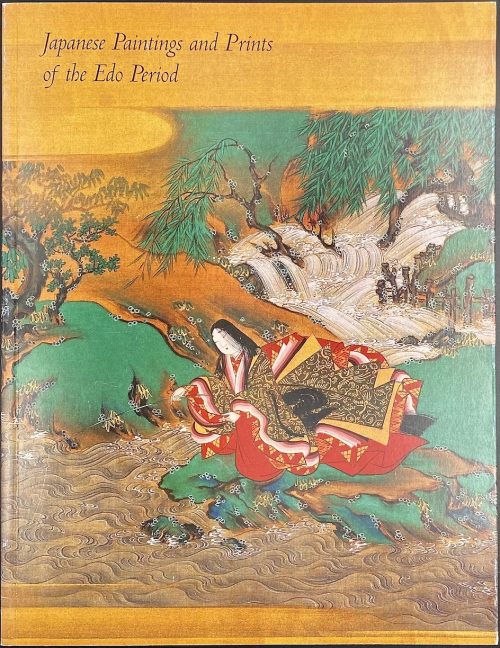 Softcover, in pictorial wrappers, 28 x 21.8 cm, 18 entries, with colour illustrations, some folding. Catalogue of the sales exhibition on September 15-18, 1998 in NY; pagination: [2] 3-43 [1], ils. Contributor: Sebastian Izzard
Softcover, in pictorial wrappers, 28 x 21.8 cm, 18 entries, with colour illustrations, some folding. Catalogue of the sales exhibition on September 15-18, 1998 in NY; pagination: [2] 3-43 [1], ils. Contributor: Sebastian Izzard -
 The left sheet of (optional) triptych: Geisha of the Shimanouchi district: Actor Nakamura Utaemon III as Danshichi no Mohei, from Three Pleasures of Present-day Osaka (Tōsei Naniwa no sankō)「当世浪花の三興 島之内」 「団七の茂兵衛」 三代目中村歌右衛門. Publisher: Iseya Rihei [伊勢屋利兵衛] (Japanese, fl. 1790s – c. 1879) Year: 1821 (Bunsei 4). Size: Vertical ōban; 36.5 x 25.1 cm. Signed: 於浮瀬亭国貞画 – Drawn by Kunisada in Ukabuse (Ukabuse ni oite Kunisada ga). Ukabuse is the name of a famous restaurant in Osaka, this signature can be found only on a three print bijin series [Kunisada Project]. Censor's seal: kiwame 改印:極 Actor Nakamura Utaemon III [中村歌右衛門] (Japanese, 1778 – 1838); other names: Nakamura Tamasuke, Nakamura Baigyoku I, Nakamura Shikan I, Kagaya Fukunosuke I. Character: Danshichi no Mohei [団七茂兵衛]. Ref: MFA ACCESSION NUMBER 11.21936; LIB-2967.2022 Izzard. Full series (triptych) Three Pleasures of Present-day Osaka (Tōsei Naniwa no sankō):
The left sheet of (optional) triptych: Geisha of the Shimanouchi district: Actor Nakamura Utaemon III as Danshichi no Mohei, from Three Pleasures of Present-day Osaka (Tōsei Naniwa no sankō)「当世浪花の三興 島之内」 「団七の茂兵衛」 三代目中村歌右衛門. Publisher: Iseya Rihei [伊勢屋利兵衛] (Japanese, fl. 1790s – c. 1879) Year: 1821 (Bunsei 4). Size: Vertical ōban; 36.5 x 25.1 cm. Signed: 於浮瀬亭国貞画 – Drawn by Kunisada in Ukabuse (Ukabuse ni oite Kunisada ga). Ukabuse is the name of a famous restaurant in Osaka, this signature can be found only on a three print bijin series [Kunisada Project]. Censor's seal: kiwame 改印:極 Actor Nakamura Utaemon III [中村歌右衛門] (Japanese, 1778 – 1838); other names: Nakamura Tamasuke, Nakamura Baigyoku I, Nakamura Shikan I, Kagaya Fukunosuke I. Character: Danshichi no Mohei [団七茂兵衛]. Ref: MFA ACCESSION NUMBER 11.21936; LIB-2967.2022 Izzard. Full series (triptych) Three Pleasures of Present-day Osaka (Tōsei Naniwa no sankō):


-
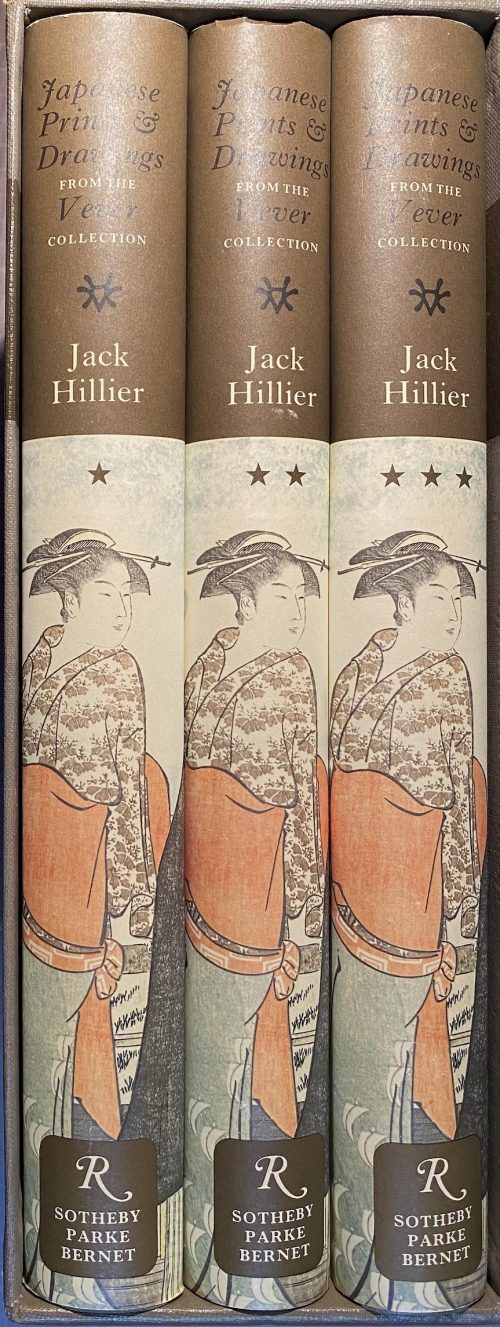 Description: Three volumes, in brown cloth, gilt-lettered to front and spine, in pictorial dust jacket, 34 x 25 cm each, T.E.G., in a slipcase 35 x 25.5 x 13.5 cm. Pagination: Vol. 1: [i-vi] vii-xix [xx] 1-349 [1 blank], ils. №№ 1-382; Vol. 2: [7] 350-673 [1], ils. №№ 383-667 ; Vol. 3: [7] 674-1034, ils. №№ 668-973. Edition: Limited edition of 2,000 copies of which this is copy № 935. Title-page: JACK HILLIER | Japanese Prints | & Drawings from | the Vever Collection | Volume One (Two; Three) | Rizzoli International | Sotheby Parke Bernet | 1976 || Contributors: Jack Ronald Hillier (British, 1912 – 1995) Henri Vever (French, 1854 – 1942)
Description: Three volumes, in brown cloth, gilt-lettered to front and spine, in pictorial dust jacket, 34 x 25 cm each, T.E.G., in a slipcase 35 x 25.5 x 13.5 cm. Pagination: Vol. 1: [i-vi] vii-xix [xx] 1-349 [1 blank], ils. №№ 1-382; Vol. 2: [7] 350-673 [1], ils. №№ 383-667 ; Vol. 3: [7] 674-1034, ils. №№ 668-973. Edition: Limited edition of 2,000 copies of which this is copy № 935. Title-page: JACK HILLIER | Japanese Prints | & Drawings from | the Vever Collection | Volume One (Two; Three) | Rizzoli International | Sotheby Parke Bernet | 1976 || Contributors: Jack Ronald Hillier (British, 1912 – 1995) Henri Vever (French, 1854 – 1942) -
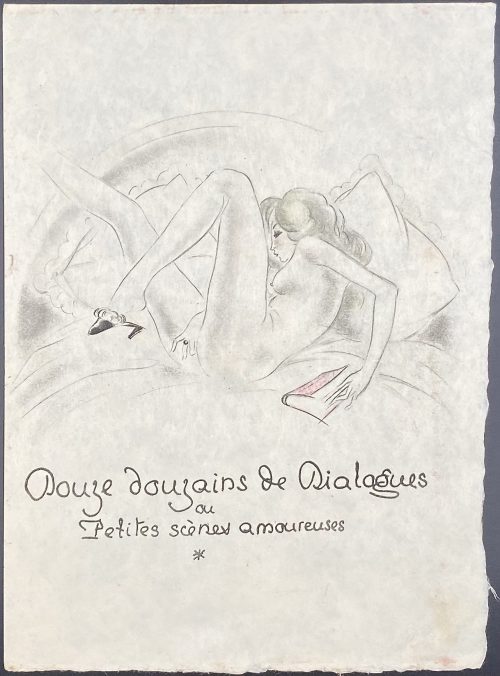 Description: An unbound softcover volume 23.5 x 18 cm collated in 4to, text in fac-simile manuscript printed on Japon Nacre wove paper with untrimmed outer and bottom margins, with 12 laid-in hand-coloured etchings, including the title-page, after André Collot; in red quarter morocco over marbled boards folder with gilt lettering to spine “P. L. | ~ | PETITES | SCÈNES | AMOUREUSES”, in a red faux ostrich leather clamshell box 26.7 x 21 cm. A copy without the limitation page. Title-page: {vignette in colour} | Douze douzains de Dialogues | ou | Petites scènes amoureuses | * || (text in fac-simile ms). Content: (97 dialogues, not 144), similar to Pia: Premier douzain : Dialogues des Filles nues (1, 3, 4, 5, 6) – 5 dialogues; Deuxième douzain : Dialogue[s] des Masturbées (13, 14, 15, 16, 17, 18, 19, 20, [21]) – 9 dialogues; Troisième douzain : Dialogues des Masturbées (25, 26, 27, [28], 29, 30, 31, 32, 33) – 9 dialogues; Quatrième douzain : Dialogues des Lécheuses (37, 38, 39, 40, 41, 42, 44) – 7 dialogues; Cinquième douzain : Dialogues des Phallophores (49, 50, 51, 52, 53, 54) – 6 dialogues; Sixième douzain : Dialogues des Goules (61, 62, 63, 64, 65, 65 (i.e. 66), 67, 68, 69, 70, 71) – 11 dialogues; Septième douzain : Dialogues des Amoureuses (73, 74, 75, 76, 77, 78, 79, [80]) – 8 dialogues; Huitième douzain : Dialogues des Enculées (85, 86, 87, 88, 89, 90, 91, 92, 93, 94, [95]) – 11 dialogues; Neuvième douzain : Dialogues des Chieuses (97, 98, 99, 100, 101, 102, 104) – 7 dialogues; Dixième douzain : Dialogues des Pisseuses (109, 110, 111, 112, 114) – 5 dialogues; Onzième douzain : Dialogues des Mères (121, 122, 123, 124, 125, 126, 127, 128, 129, 130, 131, 132) – 12 dialogues; Douzième douzain : Dialogues des Enfants (134, 135, 136, 137, 138, 139, [140]) – 7 dialogues. Collation: unpaginated, unbound [1]2 [16]4; total 66 leaves plus 12 plates, incl. t.p. In reality, when compared with another copy of the same book [LIB-3144.2023], the first gathering should have consisted of four leaves: 11 blanks, 12 engraved t.p. / blank, 13 blank / limitation, 14 faux t.p. Premier Douzain Dialogues des Filles nues. Edition: This copy of "calligraphié" Douze douzains de dialogues ou petites scènes amoureuses was most probably published in Paris by Libraire Robert Télin in 1927, 100 copies on Japon Nacre as per Dutel (1920-1970) № 1427. However, per Dutel (1) the title-page lettering is all in capital letters, (2) the illustration printed on p. 545 differs from the one in my copy, (3) the number of leaves is 68, while in my copy it is 66. Another "calligraphié" edition published in c. 1940 (Dutel 1429) is bound and has 80 leaves. Dutel unequivocally attributes the drawings to André Collot. Plates in this copy are similar to the ones in a pirated copy of Scènes de péripatéticiennes / Douze douzains de dialogues [LIB-2961.2022] (Dutel № 2366). According to Pia (1978) № 358, this is a 1927 edition published in Paris by libraire Robert Télin: « 1 f. blanc, 1 f. (justification), 1 f. (titre) et 65 ff. n. ch., plus 11 gravures à l’eau-forte rehaussées de couleurs ». Pia describes the folder and the box (chemise et étui) with lettering to spine almost as in my case: “P. L. | – | Petites | scènes | amoureuses” (lower case). Per Pia, illustrations are after André Collot (French, 1897 – 1976) or Louis Berthomme Saint-André (French, 1905 – 1977). Edition limited to 100 copies numbered I – C. There is no limitation statement in my copy, which may explain why my copy has fewer leaves than per Dutel and Pia. Catalogue raisonné: Dutel (1920-1970) №№ 1427 and 1429, p. 137 and № 2366, p. 356 ; Pia (1978) 358-9, p. 199-200. Contributors: Pierre Louÿs (French, 1870 – 1925) – author. André Collot (French, 1897 – 1976) – artist.
Description: An unbound softcover volume 23.5 x 18 cm collated in 4to, text in fac-simile manuscript printed on Japon Nacre wove paper with untrimmed outer and bottom margins, with 12 laid-in hand-coloured etchings, including the title-page, after André Collot; in red quarter morocco over marbled boards folder with gilt lettering to spine “P. L. | ~ | PETITES | SCÈNES | AMOUREUSES”, in a red faux ostrich leather clamshell box 26.7 x 21 cm. A copy without the limitation page. Title-page: {vignette in colour} | Douze douzains de Dialogues | ou | Petites scènes amoureuses | * || (text in fac-simile ms). Content: (97 dialogues, not 144), similar to Pia: Premier douzain : Dialogues des Filles nues (1, 3, 4, 5, 6) – 5 dialogues; Deuxième douzain : Dialogue[s] des Masturbées (13, 14, 15, 16, 17, 18, 19, 20, [21]) – 9 dialogues; Troisième douzain : Dialogues des Masturbées (25, 26, 27, [28], 29, 30, 31, 32, 33) – 9 dialogues; Quatrième douzain : Dialogues des Lécheuses (37, 38, 39, 40, 41, 42, 44) – 7 dialogues; Cinquième douzain : Dialogues des Phallophores (49, 50, 51, 52, 53, 54) – 6 dialogues; Sixième douzain : Dialogues des Goules (61, 62, 63, 64, 65, 65 (i.e. 66), 67, 68, 69, 70, 71) – 11 dialogues; Septième douzain : Dialogues des Amoureuses (73, 74, 75, 76, 77, 78, 79, [80]) – 8 dialogues; Huitième douzain : Dialogues des Enculées (85, 86, 87, 88, 89, 90, 91, 92, 93, 94, [95]) – 11 dialogues; Neuvième douzain : Dialogues des Chieuses (97, 98, 99, 100, 101, 102, 104) – 7 dialogues; Dixième douzain : Dialogues des Pisseuses (109, 110, 111, 112, 114) – 5 dialogues; Onzième douzain : Dialogues des Mères (121, 122, 123, 124, 125, 126, 127, 128, 129, 130, 131, 132) – 12 dialogues; Douzième douzain : Dialogues des Enfants (134, 135, 136, 137, 138, 139, [140]) – 7 dialogues. Collation: unpaginated, unbound [1]2 [16]4; total 66 leaves plus 12 plates, incl. t.p. In reality, when compared with another copy of the same book [LIB-3144.2023], the first gathering should have consisted of four leaves: 11 blanks, 12 engraved t.p. / blank, 13 blank / limitation, 14 faux t.p. Premier Douzain Dialogues des Filles nues. Edition: This copy of "calligraphié" Douze douzains de dialogues ou petites scènes amoureuses was most probably published in Paris by Libraire Robert Télin in 1927, 100 copies on Japon Nacre as per Dutel (1920-1970) № 1427. However, per Dutel (1) the title-page lettering is all in capital letters, (2) the illustration printed on p. 545 differs from the one in my copy, (3) the number of leaves is 68, while in my copy it is 66. Another "calligraphié" edition published in c. 1940 (Dutel 1429) is bound and has 80 leaves. Dutel unequivocally attributes the drawings to André Collot. Plates in this copy are similar to the ones in a pirated copy of Scènes de péripatéticiennes / Douze douzains de dialogues [LIB-2961.2022] (Dutel № 2366). According to Pia (1978) № 358, this is a 1927 edition published in Paris by libraire Robert Télin: « 1 f. blanc, 1 f. (justification), 1 f. (titre) et 65 ff. n. ch., plus 11 gravures à l’eau-forte rehaussées de couleurs ». Pia describes the folder and the box (chemise et étui) with lettering to spine almost as in my case: “P. L. | – | Petites | scènes | amoureuses” (lower case). Per Pia, illustrations are after André Collot (French, 1897 – 1976) or Louis Berthomme Saint-André (French, 1905 – 1977). Edition limited to 100 copies numbered I – C. There is no limitation statement in my copy, which may explain why my copy has fewer leaves than per Dutel and Pia. Catalogue raisonné: Dutel (1920-1970) №№ 1427 and 1429, p. 137 and № 2366, p. 356 ; Pia (1978) 358-9, p. 199-200. Contributors: Pierre Louÿs (French, 1870 – 1925) – author. André Collot (French, 1897 – 1976) – artist. -
 Artist: Utagawa Kunisada [歌川 国貞] a.k.a. Utagawa Toyokuni III [三代歌川豊国] (Japanese, 1786 – 1865). Signed: Toyokuni ga [豊国 画] in a red toshidama cartouche. Publisher: Ibaya Senzaburō [伊場屋仙三郎] (Japanese, c. 1815 – 1869). Block carver: Yokokawa Takejirō [横川竹二郎] (Japanese, fl. 1845 – 1863); seal Hori Take [彫竹]. Double nanushi censor seals: Mera & Murata (1847-50). Title: Cool Breeze on Tenpōzan Hill in Naniwa [浪花天保山の涼] (Naniwa Tenpōzan no ryō). An uncut fan print (uchiwa-e), depicting a gentleman (most probably kabuki actor Nakamura Utaemon IV) holding a pipe with the view of Tenpōzan Hill [天保山] in Naniwa (Osaka) in the background. A distinctive structure on the left is the Sumiyoshi Lantern [住吉高灯篭] (Sumiyoshi takadōrō), which was destroyed by a typhoon in 1950. The character 翫 – moteasobu – on the gentleman’s robe means "take pleasure, play an instrument". Nakamura Utaemon IV [中村歌右衛門] (Japanese, 1796 – 1852); other names: Nakamura Shikan II, Nakamura Tsurusuke I, Nakamura Tōtarō. The character is visually similar to a gentleman drinking tea on a veranda under the shining moon from the series ‘Moon, Sun, Stars’ [月日星] (Getsu hi hoshi), see SVJP-0211-1.2016: The Moon.
Artist: Utagawa Kunisada [歌川 国貞] a.k.a. Utagawa Toyokuni III [三代歌川豊国] (Japanese, 1786 – 1865). Signed: Toyokuni ga [豊国 画] in a red toshidama cartouche. Publisher: Ibaya Senzaburō [伊場屋仙三郎] (Japanese, c. 1815 – 1869). Block carver: Yokokawa Takejirō [横川竹二郎] (Japanese, fl. 1845 – 1863); seal Hori Take [彫竹]. Double nanushi censor seals: Mera & Murata (1847-50). Title: Cool Breeze on Tenpōzan Hill in Naniwa [浪花天保山の涼] (Naniwa Tenpōzan no ryō). An uncut fan print (uchiwa-e), depicting a gentleman (most probably kabuki actor Nakamura Utaemon IV) holding a pipe with the view of Tenpōzan Hill [天保山] in Naniwa (Osaka) in the background. A distinctive structure on the left is the Sumiyoshi Lantern [住吉高灯篭] (Sumiyoshi takadōrō), which was destroyed by a typhoon in 1950. The character 翫 – moteasobu – on the gentleman’s robe means "take pleasure, play an instrument". Nakamura Utaemon IV [中村歌右衛門] (Japanese, 1796 – 1852); other names: Nakamura Shikan II, Nakamura Tsurusuke I, Nakamura Tōtarō. The character is visually similar to a gentleman drinking tea on a veranda under the shining moon from the series ‘Moon, Sun, Stars’ [月日星] (Getsu hi hoshi), see SVJP-0211-1.2016: The Moon. As noted by Horst Graebner, the gentleman also resembles the character on another Kunisada's actor print, published in 1852 (Waseda University Cultural Resources Database № 114-0232):
As noted by Horst Graebner, the gentleman also resembles the character on another Kunisada's actor print, published in 1852 (Waseda University Cultural Resources Database № 114-0232):

-
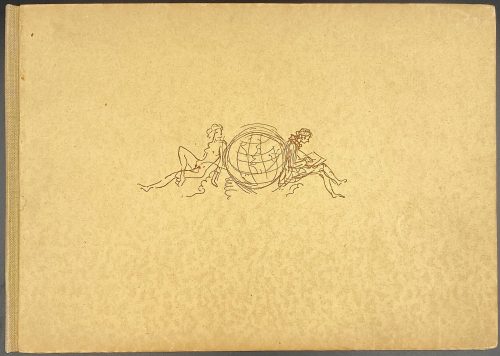 Title-page: JOHANN WOLFGANG GOETHE | DAS TAGEBUCH | Mit handkolorierten Zeichnungen von Max Schwimmer || Description: Oblong cardboard binding 24.5 x 17.5 cm, with sanguine vignette to front cover, 28 unpaginated leaves, 24 hand-coloured etchings on verso of each leaf with text on recto, numbered edition, this is № 549, signed by the artist (pencil). Contributors: Max Schwimmer (German, 1895 – 1960) – atrist. Johann Wolfgang von Goethe (German, 1749 – 1832) – author.
Title-page: JOHANN WOLFGANG GOETHE | DAS TAGEBUCH | Mit handkolorierten Zeichnungen von Max Schwimmer || Description: Oblong cardboard binding 24.5 x 17.5 cm, with sanguine vignette to front cover, 28 unpaginated leaves, 24 hand-coloured etchings on verso of each leaf with text on recto, numbered edition, this is № 549, signed by the artist (pencil). Contributors: Max Schwimmer (German, 1895 – 1960) – atrist. Johann Wolfgang von Goethe (German, 1749 – 1832) – author. -
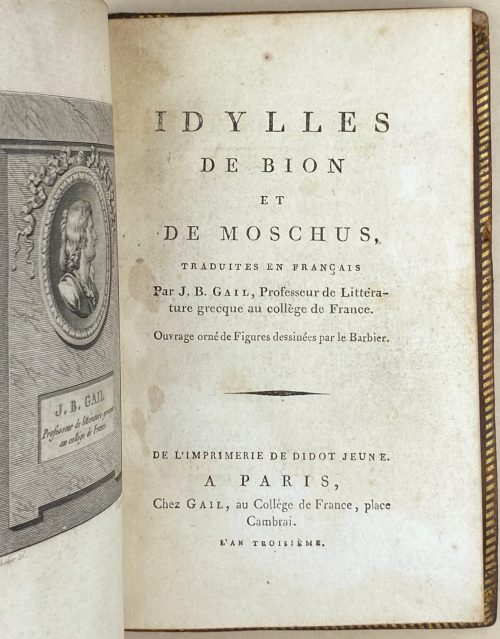 Title-page: IDYLLES | DE BION | ET | DE MOSCHUS, | TRADUITES EN FRANÇAIS | Par J. B. Gail, Professeur de littéra- | ture grecque au collège de France. | Ouvrage orné de Figures dessinées par le Barbier. | DE L’IMPRIMERIE DE DIDOT JEUNE. | A PARIS, | Chez Gail, au Collège de France, place | Cambrai. | L’AN TROISIEME. || Small volume in-12mo, 14.7 x 10 cm, bound in tree calf with gilt ornamental border, flat spine with gilt lozenges in compartments, lacking upper label and half of the lower label, gilt dentelle inside, marbled endpapers, all edges gilt. Collation: 1st and last leaves blank, [1]-96, total 54 leaves and 9 engraved plates, incl. frontispiece. Pagination: [1-5] 6-106 [2] (notice), total 108 pages, ils. Illustrations: (1) Frontispiece bust portrait of Jean-Baptiste Gail in two states, one proof before letters signed Le Barbier del., — C. S. Gaucher inc. a. ƒ., the other in finished state lettered « J. B. Gail | Professeur de littérature grecque | au collège de France » signed Le Barbier del. — C. S. Gaucher incid. (2) Le tombeau d’Adonis in two states, the first unsigned, the second signed by Le Barbier and Gaucher in Greek Λε Βαρβιερ εγραφε — Γαυχερ εχαλχενε, with tissue guard. (3) Enlèvement d’Europe in two states, the first signed Baquoy fecit., the second Le Barbier inv. — Delignon Sculp. (4) Amour du fleuve Alphée pour la fontaine Aréthuse in two states, the first unsigned, the second signed Le Barbier inv. — Dambrun. (5) Daphnis et Naïs only in final state signed by Le Barbier and Gaucher in Greek Λε Βαρβιερ εγρφε — Γαυχερ εχαλχενε. (sic.) Catalogue raisonné: Cohen-DeRicci 151-2, attributes to 1895, in-18, Daphnis et Naïs without the proof state; Lewine 64, "very scarce, particularly that of the portrait, a fancy price". Contributors: Bion [Βίων] (fl. late 2nd century BCE, Phlossa near Smyrna) – author. Moschus [Μόσχος] (fl. mid 2nd century BCE, Syracuse) – author. Jean-Baptiste Gail (French, 1755 – 1829) – translator. Jean-Jacques-François Le Barbier (French, 1738 – 1826) – artist. Charles-Étienne Gaucher (French, 1740 – 1804) – engraver. Jean-Louis Delignon (French, 1755 – 1820) – engraver. Jean Dambrun (1741 – 1808/14) – engraver. Pierre François Didot, Le Jeune (French, 1732 – 1795) – publisher.
Title-page: IDYLLES | DE BION | ET | DE MOSCHUS, | TRADUITES EN FRANÇAIS | Par J. B. Gail, Professeur de littéra- | ture grecque au collège de France. | Ouvrage orné de Figures dessinées par le Barbier. | DE L’IMPRIMERIE DE DIDOT JEUNE. | A PARIS, | Chez Gail, au Collège de France, place | Cambrai. | L’AN TROISIEME. || Small volume in-12mo, 14.7 x 10 cm, bound in tree calf with gilt ornamental border, flat spine with gilt lozenges in compartments, lacking upper label and half of the lower label, gilt dentelle inside, marbled endpapers, all edges gilt. Collation: 1st and last leaves blank, [1]-96, total 54 leaves and 9 engraved plates, incl. frontispiece. Pagination: [1-5] 6-106 [2] (notice), total 108 pages, ils. Illustrations: (1) Frontispiece bust portrait of Jean-Baptiste Gail in two states, one proof before letters signed Le Barbier del., — C. S. Gaucher inc. a. ƒ., the other in finished state lettered « J. B. Gail | Professeur de littérature grecque | au collège de France » signed Le Barbier del. — C. S. Gaucher incid. (2) Le tombeau d’Adonis in two states, the first unsigned, the second signed by Le Barbier and Gaucher in Greek Λε Βαρβιερ εγραφε — Γαυχερ εχαλχενε, with tissue guard. (3) Enlèvement d’Europe in two states, the first signed Baquoy fecit., the second Le Barbier inv. — Delignon Sculp. (4) Amour du fleuve Alphée pour la fontaine Aréthuse in two states, the first unsigned, the second signed Le Barbier inv. — Dambrun. (5) Daphnis et Naïs only in final state signed by Le Barbier and Gaucher in Greek Λε Βαρβιερ εγρφε — Γαυχερ εχαλχενε. (sic.) Catalogue raisonné: Cohen-DeRicci 151-2, attributes to 1895, in-18, Daphnis et Naïs without the proof state; Lewine 64, "very scarce, particularly that of the portrait, a fancy price". Contributors: Bion [Βίων] (fl. late 2nd century BCE, Phlossa near Smyrna) – author. Moschus [Μόσχος] (fl. mid 2nd century BCE, Syracuse) – author. Jean-Baptiste Gail (French, 1755 – 1829) – translator. Jean-Jacques-François Le Barbier (French, 1738 – 1826) – artist. Charles-Étienne Gaucher (French, 1740 – 1804) – engraver. Jean-Louis Delignon (French, 1755 – 1820) – engraver. Jean Dambrun (1741 – 1808/14) – engraver. Pierre François Didot, Le Jeune (French, 1732 – 1795) – publisher. -
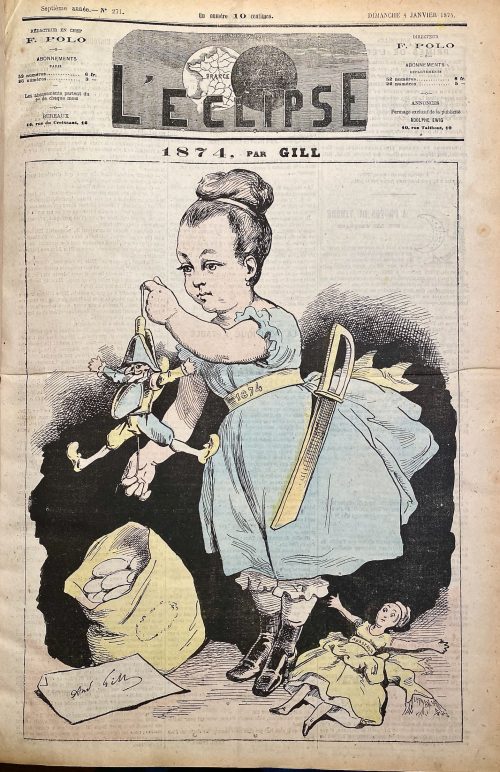 129 issues of L'Éclipse, French weekly political magazine; published in Paris, 49 x 34 cm, bound in rebacked green quarter morocco over marbled boards, with gilt fillets and lettering to spine, peacock marbled endpapers, illustrated by André Gill (French, 1840 – 1885). Founder and editor-in-chief François Polo (French, 1838 – 1874). 1874: 271-322 (52 issues) 1875: 323-374 (52 issues) 1876: 375-399 (25 issues)
129 issues of L'Éclipse, French weekly political magazine; published in Paris, 49 x 34 cm, bound in rebacked green quarter morocco over marbled boards, with gilt fillets and lettering to spine, peacock marbled endpapers, illustrated by André Gill (French, 1840 – 1885). Founder and editor-in-chief François Polo (French, 1838 – 1874). 1874: 271-322 (52 issues) 1875: 323-374 (52 issues) 1876: 375-399 (25 issues) -
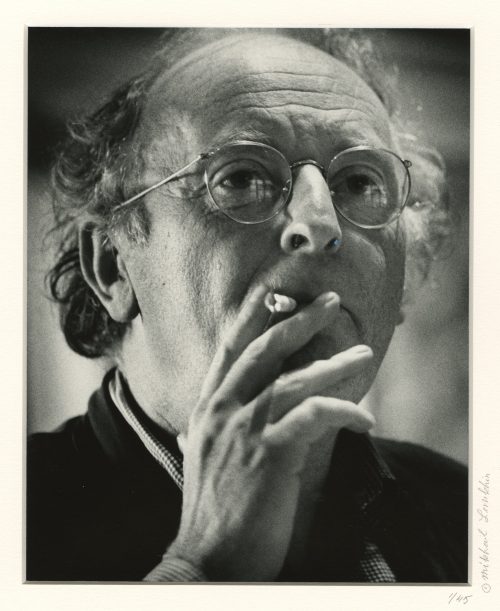 Photographic portrait of poet Joseph Brodsky, head, shoulders, and hand, three-quarters to the right, wearing glasses and with a cigarette. Pencil-signed on the mat: 1/45 • ©Mikhail Lemkhin; same inscription on the back of the print, and ink stamp ©Mikhail Lemkhin. Sitter: Joseph Brodsky [Иосиф Александрович Бродский ] (Russian-American-Jewish, 1940 – 1996). Size: mat: 43 x 35.5 cm; window: 24 x 19 cm.
Photographic portrait of poet Joseph Brodsky, head, shoulders, and hand, three-quarters to the right, wearing glasses and with a cigarette. Pencil-signed on the mat: 1/45 • ©Mikhail Lemkhin; same inscription on the back of the print, and ink stamp ©Mikhail Lemkhin. Sitter: Joseph Brodsky [Иосиф Александрович Бродский ] (Russian-American-Jewish, 1940 – 1996). Size: mat: 43 x 35.5 cm; window: 24 x 19 cm. -
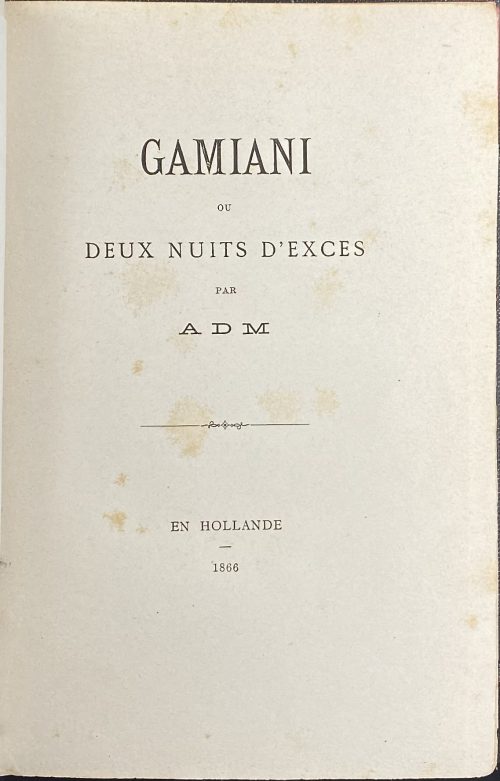 Single volume, 18 x 12.5 cm, bound in ¾ crimson morocco over marbled boards, gilt double-fillet borders, spine with gilded raised bands, gilt in compartments, gilt-lettered label, marbled endpapers, top margin gilt, text printed on dense wove paper, with 8 etchings by anonymous on thin laid paper (Chine) with tissue guards, after original lithographs by Devéria and Henri Grévedon or Octave Tassaert for the 1833 edition (1926 re-print LIB-3135.2023); the plate with the ape after 1864 edition (LIB-3087.2022) and the plate with the donkey after unknown. Title-page: GAMIANI | OU | DEUX NUITS D’EXCES | PAR | A D M | — | EN HOLLANDE | – | 1866 || Pagination: [4] (h.t., t.p.), [i] ii-xvi, [3] 4-153 [154 blank]; total 158 pages plus 8 plates (anonymous etchings), incl. frontispiece. Catalogue raisonné: Dutel I: A-470; Pia: 518/9. BNF Enfer 418. Note: This edition is conformant with Dutel, but not with Pia, who mentions [2], xvi, 148 pp. Pia writes: 'According to a bibliographic record published in 1874 by Vital Puissant, this edition was printed in Brussels by Briard on behalf of Alphonse Lécrivain, a Parisian publisher who took refuge in Belgium'. Catalogue Poulet-Malassis & ses amis description: № 74. [Alfred de MUSSET] A D M. Gamiani ou deux nuits d’excès. En Hollande, 1866. In-8 de xvi, 153 pages, demi-maroquin cerise à coins, dos à nerfs orné, lets dorés sur les mors, tête dorée, tranches naturelles, couverture conservée (reliure ancienne). Illustré de 8 gravures sur Chine dont l’une en frontispice, toutes accompagnées de serpentines. Piqûres et mouillures. Dutel A-470, pas à l’Enfer de la BnF.
Single volume, 18 x 12.5 cm, bound in ¾ crimson morocco over marbled boards, gilt double-fillet borders, spine with gilded raised bands, gilt in compartments, gilt-lettered label, marbled endpapers, top margin gilt, text printed on dense wove paper, with 8 etchings by anonymous on thin laid paper (Chine) with tissue guards, after original lithographs by Devéria and Henri Grévedon or Octave Tassaert for the 1833 edition (1926 re-print LIB-3135.2023); the plate with the ape after 1864 edition (LIB-3087.2022) and the plate with the donkey after unknown. Title-page: GAMIANI | OU | DEUX NUITS D’EXCES | PAR | A D M | — | EN HOLLANDE | – | 1866 || Pagination: [4] (h.t., t.p.), [i] ii-xvi, [3] 4-153 [154 blank]; total 158 pages plus 8 plates (anonymous etchings), incl. frontispiece. Catalogue raisonné: Dutel I: A-470; Pia: 518/9. BNF Enfer 418. Note: This edition is conformant with Dutel, but not with Pia, who mentions [2], xvi, 148 pp. Pia writes: 'According to a bibliographic record published in 1874 by Vital Puissant, this edition was printed in Brussels by Briard on behalf of Alphonse Lécrivain, a Parisian publisher who took refuge in Belgium'. Catalogue Poulet-Malassis & ses amis description: № 74. [Alfred de MUSSET] A D M. Gamiani ou deux nuits d’excès. En Hollande, 1866. In-8 de xvi, 153 pages, demi-maroquin cerise à coins, dos à nerfs orné, lets dorés sur les mors, tête dorée, tranches naturelles, couverture conservée (reliure ancienne). Illustré de 8 gravures sur Chine dont l’une en frontispice, toutes accompagnées de serpentines. Piqûres et mouillures. Dutel A-470, pas à l’Enfer de la BnF. -
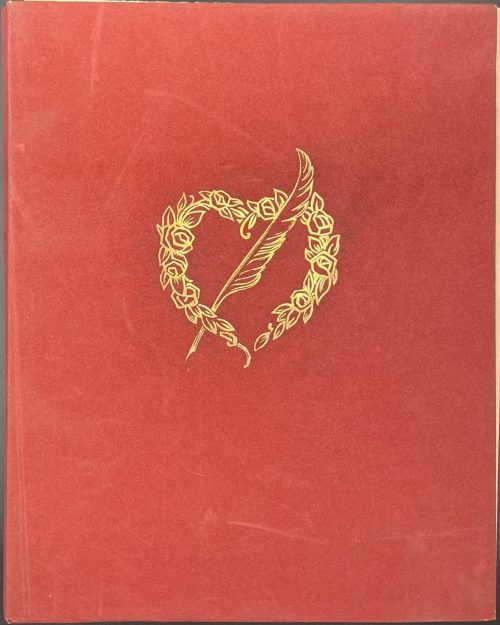 Softcover volume, 24.7 x 19.7 cm, red felt with gilt embossing to front, pages framed in red, watermarked Arches wove paper, lower and outer margins untrimmed; matted original drawing (watercolour, India ink, graphite on Arches wove paper), signed André Collot and dated 36 laid in. Title-page (red and black): ANDREA DE NERCIAT | LE DOCTORAT | IMPROMPTU | ILLUSTRÉ | D’EAUX-FORTES ORIGINALES | PAR | ANDRÉ COLLOT | {publisher’s device} | LA TRADITION | PARIS || Pagination: [2] blank, [1, 2] h.t./limitation, [3, 4] frontis., [5, 6] t.p./blank, 7-125 [126] blank, [2] colophon/blank, [2] blank; 7 full-page (incl. frontispiece) and 9 half-page plates, 2 tailpieces and 2 initials (etching and au pochoir colouring after André Collot); total 132 pages (66 leaves, incl. plates within collation). Limitation: A print run of 500 copies; this is № 268. Colophon: Paul Durupt supervision, text at Coulouma / H. Barthélemy, plates at La Tradition (Paris); date of printing: 30-APR-1935 Contributors: André-Robert Andréa de Nerciat (French, 1739 – 1800) – author. André Collot (French, 1897 – 1976) – artist.
Softcover volume, 24.7 x 19.7 cm, red felt with gilt embossing to front, pages framed in red, watermarked Arches wove paper, lower and outer margins untrimmed; matted original drawing (watercolour, India ink, graphite on Arches wove paper), signed André Collot and dated 36 laid in. Title-page (red and black): ANDREA DE NERCIAT | LE DOCTORAT | IMPROMPTU | ILLUSTRÉ | D’EAUX-FORTES ORIGINALES | PAR | ANDRÉ COLLOT | {publisher’s device} | LA TRADITION | PARIS || Pagination: [2] blank, [1, 2] h.t./limitation, [3, 4] frontis., [5, 6] t.p./blank, 7-125 [126] blank, [2] colophon/blank, [2] blank; 7 full-page (incl. frontispiece) and 9 half-page plates, 2 tailpieces and 2 initials (etching and au pochoir colouring after André Collot); total 132 pages (66 leaves, incl. plates within collation). Limitation: A print run of 500 copies; this is № 268. Colophon: Paul Durupt supervision, text at Coulouma / H. Barthélemy, plates at La Tradition (Paris); date of printing: 30-APR-1935 Contributors: André-Robert Andréa de Nerciat (French, 1739 – 1800) – author. André Collot (French, 1897 – 1976) – artist. -
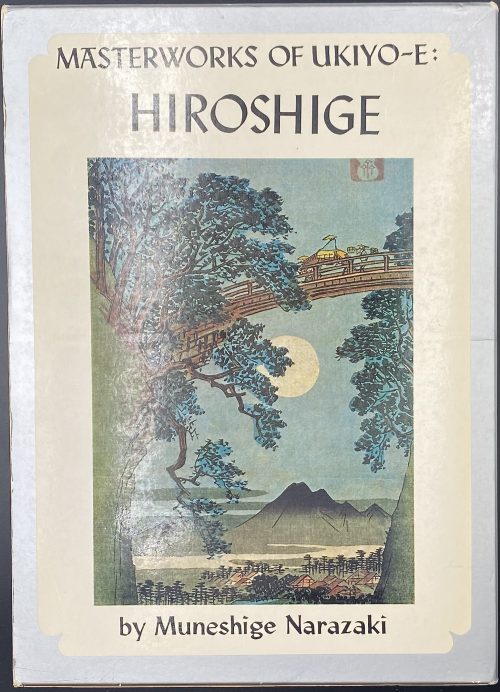 Hardcover volume from the series Masterworks of ukiyo-e, 26.3 x 19 cm, bound in unprimed canvas, red characters on black strip to front, red and black lettering to spine, tan flat endpapers, in a pictorial slipcase with series design (black lettering on silver spine); pp: [1-6]: h.t./frontis. (colour plate pasted in), t.p./imprint, contents/acknowledgements), 7-67 text, 27-30 map, 31-32 f.t./blank, 33-96 (65 plates w/captions). Title-page (in frame): MASTERWORKS OF UKIYO-E | HIROSHIGE | FAMOUS VIEWS | by Muneshige Narazaki | English adaptation by Richard L. Gage | {publisher’s device} | KODANSHA INTERNATIONAL LTD. | Tokyo, Japan & Palo-Alto, Calif., U.S.A | {vertical, between rules in ms 広重]} || Series: Masterworks of ukiyo-e, № 5. Edition: 1st edition ©1968, 2nd printing 1970. Muneshige Narazaki [楢崎 宗重] (Japanese, 1904 – 2001) – author. Utagawa Hiroshige [歌川 広重] a.k.a. Andō Hiroshige [安藤 広重] (Japanese, 1797 – 1858) – artist. Richard L. Gage (American, b. 1934) – adaptation.
Hardcover volume from the series Masterworks of ukiyo-e, 26.3 x 19 cm, bound in unprimed canvas, red characters on black strip to front, red and black lettering to spine, tan flat endpapers, in a pictorial slipcase with series design (black lettering on silver spine); pp: [1-6]: h.t./frontis. (colour plate pasted in), t.p./imprint, contents/acknowledgements), 7-67 text, 27-30 map, 31-32 f.t./blank, 33-96 (65 plates w/captions). Title-page (in frame): MASTERWORKS OF UKIYO-E | HIROSHIGE | FAMOUS VIEWS | by Muneshige Narazaki | English adaptation by Richard L. Gage | {publisher’s device} | KODANSHA INTERNATIONAL LTD. | Tokyo, Japan & Palo-Alto, Calif., U.S.A | {vertical, between rules in ms 広重]} || Series: Masterworks of ukiyo-e, № 5. Edition: 1st edition ©1968, 2nd printing 1970. Muneshige Narazaki [楢崎 宗重] (Japanese, 1904 – 2001) – author. Utagawa Hiroshige [歌川 広重] a.k.a. Andō Hiroshige [安藤 広重] (Japanese, 1797 – 1858) – artist. Richard L. Gage (American, b. 1934) – adaptation. -
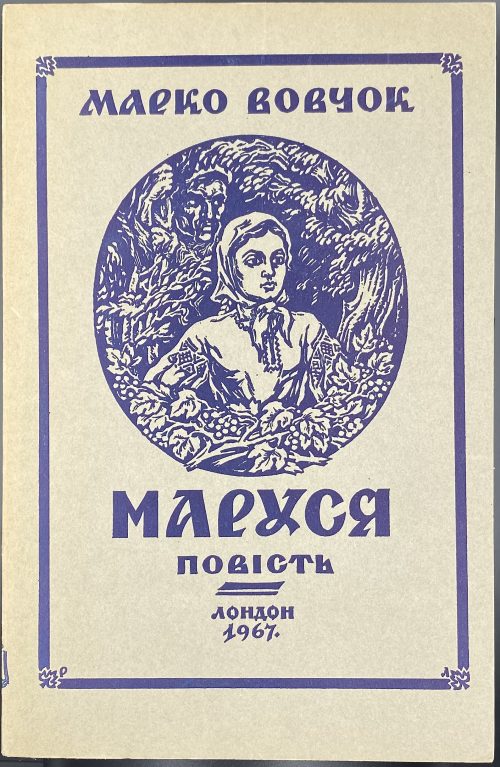 Paperback, 21.3 x 14 cm, original grey wrappers, vignette and lettering in frame, lettering to spine, publisher’s device to back, all in blue; pp.: [1-4] 5-112. Title-page: МАРКО ВОВЧОК | МАРУСЯ | ПОВIСТЬ | {fleuron} | ВИДАННЯ | СОЮЗУ УКРАÏНЦIВ У ВЕЛИКIЙ БРИТАНIÏ | ЛОНДОН 1967 || Title-page verso: “MARUSIA” | by | MARKO VOVCHOK | NOVEL IN UKRAINIAN LANGUAGE | — | REPRINT | — | Republished by | ASSOCIATION OF UKRAINIANS IN GREAT BRITAIN LTD. | (PUBLISHING DEPARTMENT) | {four lines of text in double-rules} | Printed in the United Kingdom for Association of Ukrainians | in Great Britain Ltd. by | Ukrainian Publishers Limited, 200 Liverpool Rd., London, N. 1. || The French version of the Ukrainian name Маруся —> MAROUSSIA. The French version of the book: LIB-2674.2021; another copy of the Ukrainian edition (1943): LIB-3136.2023. Other variants of the author's name Марко Вовчок: Markowovzok and Marko Vovtchok. Contributors: Марко Вовчок [Marko Vovchok; Марія Олександрівна Вілінська] (Ukrainian, 1833 – 1907) – author. Василь Миколайович Доманицький [Василий Николаевич Доманицкий; Vasyl Domanytskyi] (1877 – 1910) – translator from Russian to Ukrainian. Святомир Фостун (Ukrainian, 1924 – 2004) – foreword.
Paperback, 21.3 x 14 cm, original grey wrappers, vignette and lettering in frame, lettering to spine, publisher’s device to back, all in blue; pp.: [1-4] 5-112. Title-page: МАРКО ВОВЧОК | МАРУСЯ | ПОВIСТЬ | {fleuron} | ВИДАННЯ | СОЮЗУ УКРАÏНЦIВ У ВЕЛИКIЙ БРИТАНIÏ | ЛОНДОН 1967 || Title-page verso: “MARUSIA” | by | MARKO VOVCHOK | NOVEL IN UKRAINIAN LANGUAGE | — | REPRINT | — | Republished by | ASSOCIATION OF UKRAINIANS IN GREAT BRITAIN LTD. | (PUBLISHING DEPARTMENT) | {four lines of text in double-rules} | Printed in the United Kingdom for Association of Ukrainians | in Great Britain Ltd. by | Ukrainian Publishers Limited, 200 Liverpool Rd., London, N. 1. || The French version of the Ukrainian name Маруся —> MAROUSSIA. The French version of the book: LIB-2674.2021; another copy of the Ukrainian edition (1943): LIB-3136.2023. Other variants of the author's name Марко Вовчок: Markowovzok and Marko Vovtchok. Contributors: Марко Вовчок [Marko Vovchok; Марія Олександрівна Вілінська] (Ukrainian, 1833 – 1907) – author. Василь Миколайович Доманицький [Василий Николаевич Доманицкий; Vasyl Domanytskyi] (1877 – 1910) – translator from Russian to Ukrainian. Святомир Фостун (Ukrainian, 1924 – 2004) – foreword. -
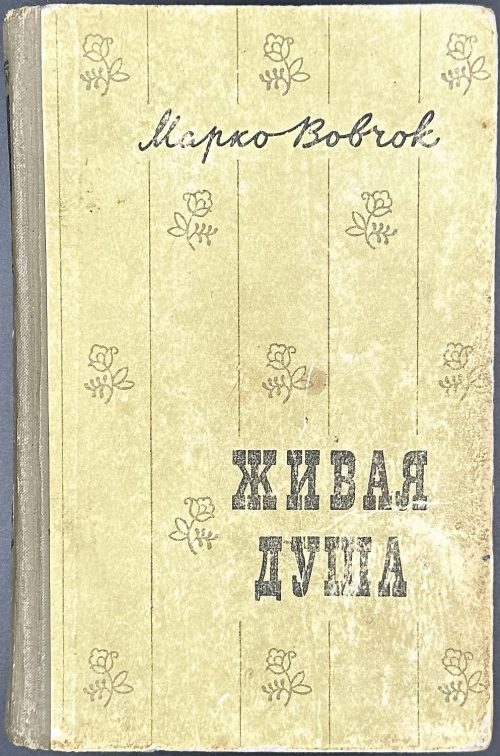 Hardcover volume 20.8 x 13.5 cm, quarter olive cloth over cardboard, diaper design with lettering to front and lettering on black label to spine; pp.: [2] blank/portrait, [1, 2] t.p./imprint, 3-331 [5], total 338 pages, linocut portrait and chapter headpieces by Volkovinskaia. Some pages spotted, about 1/3 of p. 133/134 lost. Re-printed from 6-vol. edition of Vovchok’s collected works, 1956. Title-page: МАРКО ВОВЧОК | ЖИВАЯ | ДУША | РОМАН | ИЗДАТЕЛЬСТВО ЦК ЛКСМУ «МОЛОДЬ» | КИЕВ 1962 || Print run: 50,000 copies. Contributors: Марко Вовчок [Marko Vovchok; Марія Олександрівна Вілінська] (Ukrainian, 1833 – 1907) – author. Other variants: Markowovzok and Marko Vovtchok. Зінаїда Володимирівна Волковинська [Зинаида Владимировна Волковинская; Zinaïda Volkovynsʹka] (Ukrainian, 1915 – 2010) – artist.
Hardcover volume 20.8 x 13.5 cm, quarter olive cloth over cardboard, diaper design with lettering to front and lettering on black label to spine; pp.: [2] blank/portrait, [1, 2] t.p./imprint, 3-331 [5], total 338 pages, linocut portrait and chapter headpieces by Volkovinskaia. Some pages spotted, about 1/3 of p. 133/134 lost. Re-printed from 6-vol. edition of Vovchok’s collected works, 1956. Title-page: МАРКО ВОВЧОК | ЖИВАЯ | ДУША | РОМАН | ИЗДАТЕЛЬСТВО ЦК ЛКСМУ «МОЛОДЬ» | КИЕВ 1962 || Print run: 50,000 copies. Contributors: Марко Вовчок [Marko Vovchok; Марія Олександрівна Вілінська] (Ukrainian, 1833 – 1907) – author. Other variants: Markowovzok and Marko Vovtchok. Зінаїда Володимирівна Волковинська [Зинаида Владимировна Волковинская; Zinaïda Volkovynsʹka] (Ukrainian, 1915 – 2010) – artist. -
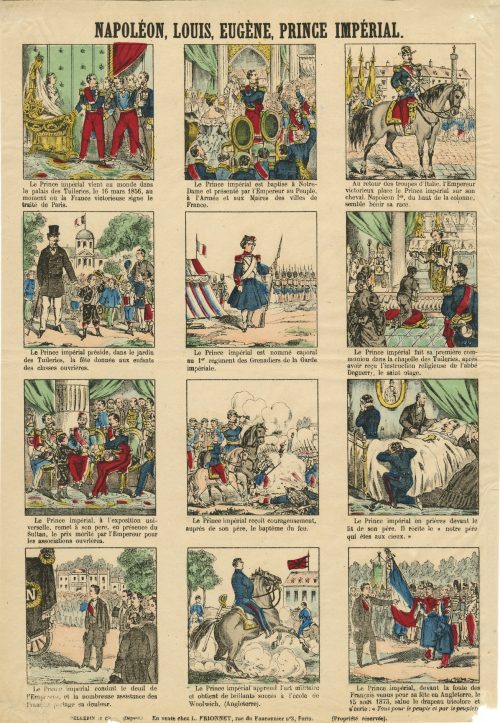 Hand-coloured woodcut on wove paper, 400 x 277 mm. Top: "NAPOLÉON, LOUIS, EUGÈNE, PRINCE IMPÉRIAL"; bellow 12 captioned frames:
Hand-coloured woodcut on wove paper, 400 x 277 mm. Top: "NAPOLÉON, LOUIS, EUGÈNE, PRINCE IMPÉRIAL"; bellow 12 captioned frames:- Le Prince impérial vient au monde dans le palais des Tuileries, le 16 mars 1856, au moment où la France victorieuse signe le traité de Paris.
- Le Prince impérial est baptisé à Notre-Dame et présenté par l'Empereur au Peuple, à l’Armée et aux Maires des villes de France.
- Au retour des troupes d'Italie, l'Empereur victorieux place le Prince impérial sur son cheval. Napoléon Ier, du haut de la colonne, semble bénir sa race.
- Le Prince impérial préside, dans le jardin des Tuileries, la fête donnée aux enfants des classes ouvrières.
- Le Prince impérial est nommé caporal au 1er régiment des Grenadiers de la Garde impériale.
- Le Prince impérial fait sa première communion dans la chapelle des Tuileries, après avoir reçu l'instruction religieuse de l'abbé Deguerry, le saint otage.
- Le Prince impérial, à l'exposition universelle, remet à son père. en présence du Sultan, le prix mérité par l'Empereur pour les associations ouvrières.
- Le Prince impérial reçoit courageusement, auprès de son père, le baptême du feu.
- Le Prince impérial en prières devant le lit de son père. Il récite le « notre père qui ètes aux cieux. »
- Le Prince impérial conduit le deuil de l'Empereur, et la nombreuse assistance des Français portage sa douleur.
- Le Prince impérial apprend l’art militaire et obtient de brillants succès à l'écolo de Woolwich, (Angleterre).
- Le Prince impérial, devant la foule des Français venus pour sa fête en Angleterre, le 15 out 1873, salue le drapeau tricolore et s'écrie : « Tout pour le peuple et par le peuple… »
-
 Three-quarter waist portrait of French actor Jean-Paul Belmondo in the film Peur sur la Ville, directed by Henri Verneuil in 1975. Autographed in black ink on a light area of the image above the head: “Pour Scott Schutte | Bien amicalement | J.P. Belmondo”. Paper watermarked "Agfa" in a diamond. Dimensions: 147 x 100 mm
Three-quarter waist portrait of French actor Jean-Paul Belmondo in the film Peur sur la Ville, directed by Henri Verneuil in 1975. Autographed in black ink on a light area of the image above the head: “Pour Scott Schutte | Bien amicalement | J.P. Belmondo”. Paper watermarked "Agfa" in a diamond. Dimensions: 147 x 100 mm -
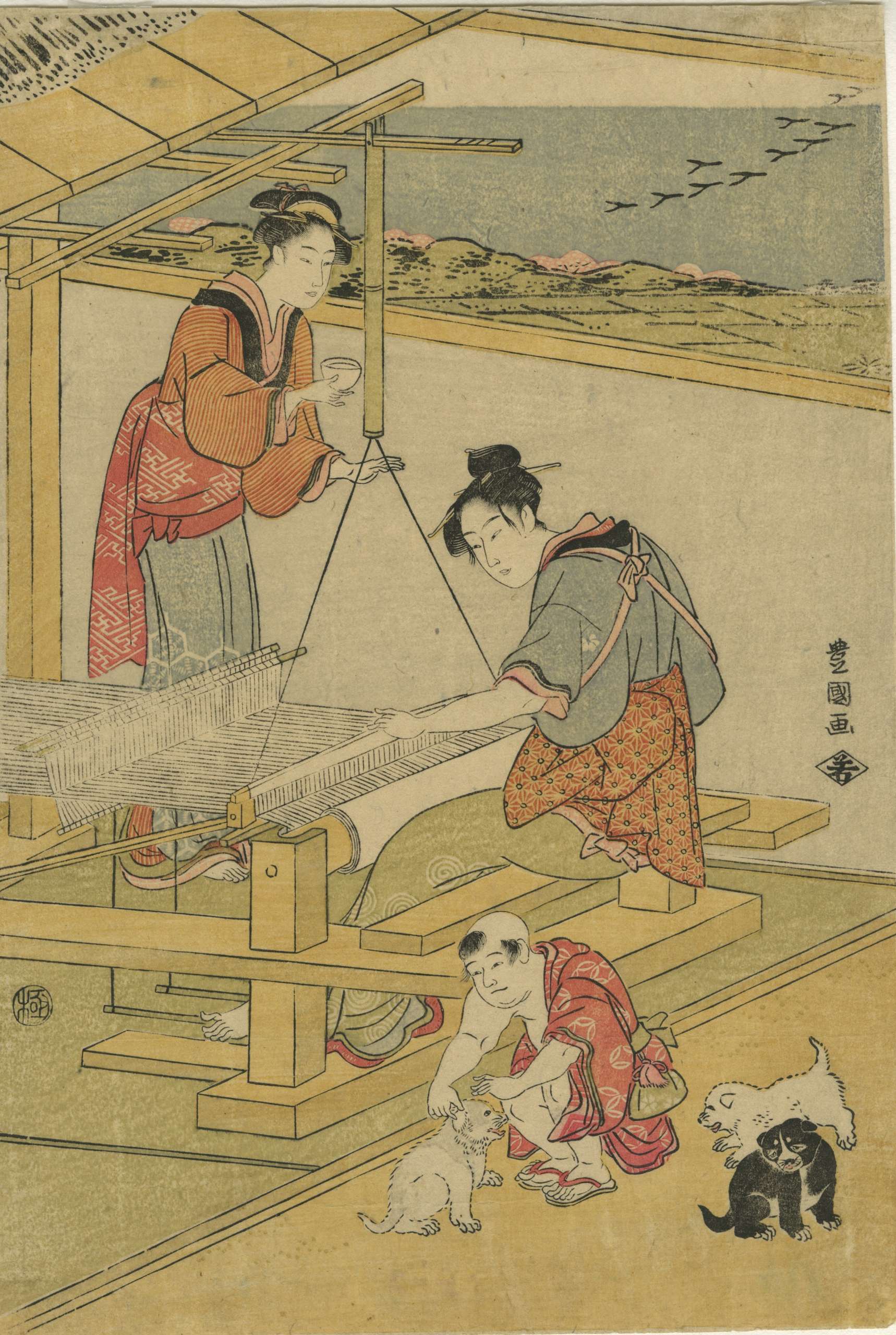 Utagawa Toyokuni I. Women Weaving and Boy Playing with Puppies. c. 1790's. Publisher Wakasaya Yoichi (Jakurindô). Vertical aiban; 32.2 x 21.5 cm (12 11/16 x 8 7/16 in.). MFA ACCESSION NUMBER 06.671. Signed Toyokuni ga 豊国画. Censor's seal: kiwame 改印:極 SOLD
Utagawa Toyokuni I. Women Weaving and Boy Playing with Puppies. c. 1790's. Publisher Wakasaya Yoichi (Jakurindô). Vertical aiban; 32.2 x 21.5 cm (12 11/16 x 8 7/16 in.). MFA ACCESSION NUMBER 06.671. Signed Toyokuni ga 豊国画. Censor's seal: kiwame 改印:極 SOLD -
 Иммануил Кант. Критика чистого разума. Пер. Н. М. Соколова. С.-Петербург. Издание книжного магазина М. В. Попова, 1897. - 674 с.
Иммануил Кант. Критика чистого разума. Пер. Н. М. Соколова. С.-Петербург. Издание книжного магазина М. В. Попова, 1897. - 674 с. -
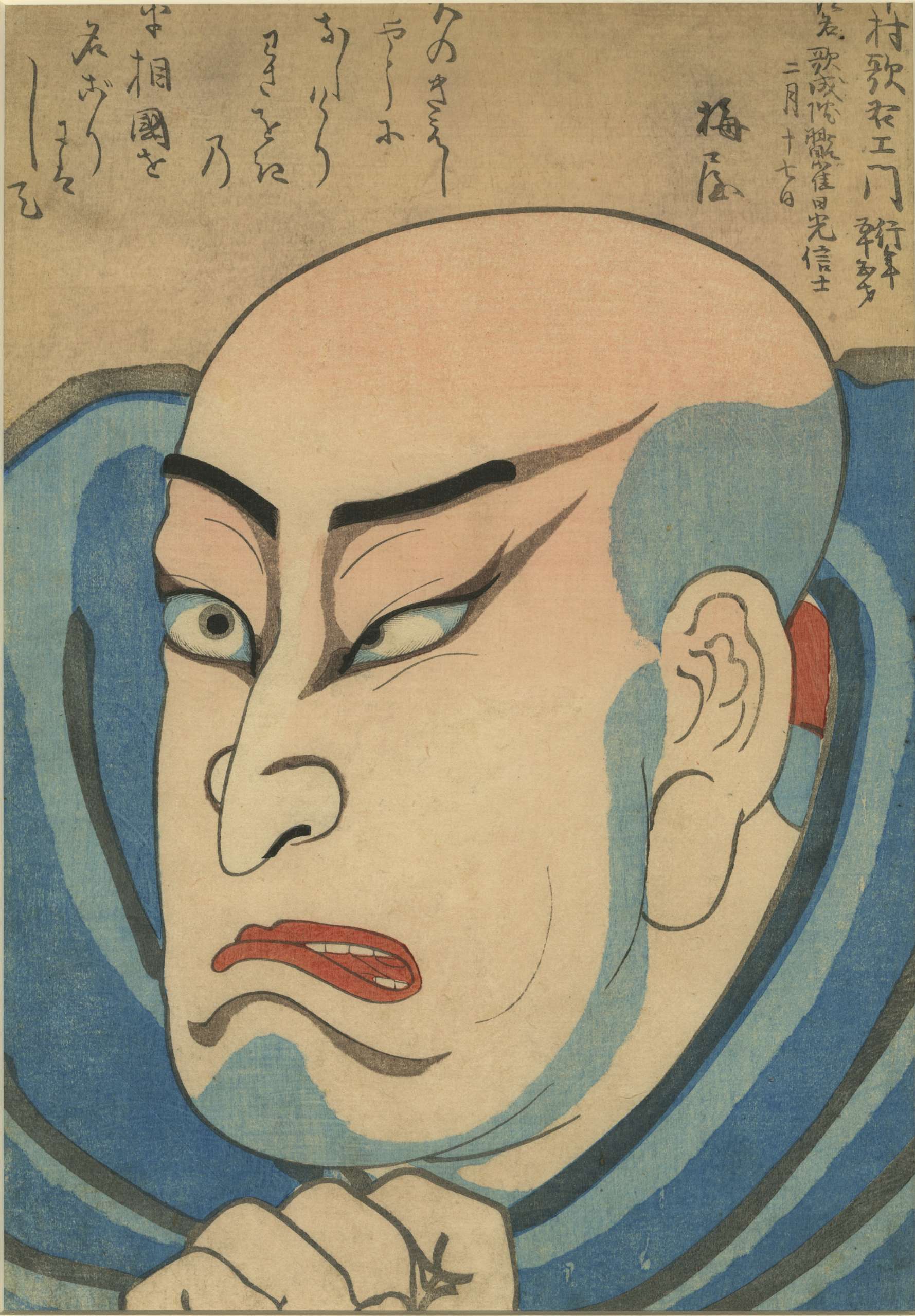 Utagawa Kuniyoshi, 歌川 国芳, January 1, 1797 – April 14, 1861. Memorial portrait (Shini-e) of Nakamura Utaemon IV as a priest. Date: 1852. Reference: Heroes and Ghosts, by Robert Schaap, 1998, p. 165 (image 176). Tokyo digital museum 番号 94202582. Provenance: Herbert Egenolf Collection, Germany. Literature: Suzuki (1992) 317. Trimmed, unsigned.
Utagawa Kuniyoshi, 歌川 国芳, January 1, 1797 – April 14, 1861. Memorial portrait (Shini-e) of Nakamura Utaemon IV as a priest. Date: 1852. Reference: Heroes and Ghosts, by Robert Schaap, 1998, p. 165 (image 176). Tokyo digital museum 番号 94202582. Provenance: Herbert Egenolf Collection, Germany. Literature: Suzuki (1992) 317. Trimmed, unsigned. -
 Iron tsuba of round form decorated with eight roundels – circular emblems of flowers and/or family crests (mon) made of cast brass, pierced and chiseled in kebori, and with flat brass inlay (hira-zōgan) of vines or leaves all over the plate. Both hitsu-ana trimmed in brass. Nakago-ana of rectangular form, with copper sekigane. Four positive openwork (ji-sukashi) roundels at 12, 3, 6, and 9 o'clock; and four negative openwork (in-sukashi) roundels with cherry blossom, bellflower, and two variations on suhama theme. Yoshirō school (Kaga-Yoshirō). The Momoyama or early Edo period, late 16th to early 17th century. Size: diameter 81.4 mm, thickness 4.7 mmat seppa-dai, 4.0 mm at rim. Christie's lot description: AN IRON TSUBA; EDO PERIOD (17TH CENTURY). THE DOLPHYN COLLECTION OF SAMURAI ART. The round iron tsuba pierced with roundels of various floral motifs interspersed among scrolling foliage, all inlaid with brass. 8.1 cm. high. Provenance: Pabst Collection (no. 338).
Iron tsuba of round form decorated with eight roundels – circular emblems of flowers and/or family crests (mon) made of cast brass, pierced and chiseled in kebori, and with flat brass inlay (hira-zōgan) of vines or leaves all over the plate. Both hitsu-ana trimmed in brass. Nakago-ana of rectangular form, with copper sekigane. Four positive openwork (ji-sukashi) roundels at 12, 3, 6, and 9 o'clock; and four negative openwork (in-sukashi) roundels with cherry blossom, bellflower, and two variations on suhama theme. Yoshirō school (Kaga-Yoshirō). The Momoyama or early Edo period, late 16th to early 17th century. Size: diameter 81.4 mm, thickness 4.7 mmat seppa-dai, 4.0 mm at rim. Christie's lot description: AN IRON TSUBA; EDO PERIOD (17TH CENTURY). THE DOLPHYN COLLECTION OF SAMURAI ART. The round iron tsuba pierced with roundels of various floral motifs interspersed among scrolling foliage, all inlaid with brass. 8.1 cm. high. Provenance: Pabst Collection (no. 338). -
 Iron tsuba of round form with design of slanting rays of light (shakoh) or clock gear (tokei) in openwork (sukashi). Commonly considered a Christian / Jesuit motif. Copper sekigane. According to seller, Owari School. Haynes writes that most tsuba of this design are Owari (Tsuba. Aesthetic Study). Unsigned. Edo period. According to F. Geyer, diamond-shaped vertical posts and long rays suggest that this tsuba was probably made between 1605 and 1630.
Iron tsuba of round form with design of slanting rays of light (shakoh) or clock gear (tokei) in openwork (sukashi). Commonly considered a Christian / Jesuit motif. Copper sekigane. According to seller, Owari School. Haynes writes that most tsuba of this design are Owari (Tsuba. Aesthetic Study). Unsigned. Edo period. According to F. Geyer, diamond-shaped vertical posts and long rays suggest that this tsuba was probably made between 1605 and 1630.Size: 76.9 x 76.0 x 5.4 mm
For information regarding shakoh tsuba see article 'Kirishitan Ikenie Tsuba by Fred Geyer at Kokusai Tosogu Kai; The 2nd International Convention & Exhibition, October 18-23, 2006, pp. 84-91. -
 Ippitsusai Bunchō (一筆斎文調); lived 1725-1794; flourished 1755–1790. Size: Chuban; 26 x 20 cm The design presents a young woman reading a scroll while arranging her hear, and a young man with a rowing rod watching over her shoulder; the pair is standing on a giant shrimp that ferries them over a stream. The third passenger is a literate octopus, who's is attentively exploring the text of a scroll. This allusion comes to mind promptly: “Bodhidharma crossing the Yangzi River on a reed” (Royō Daruma).
Ippitsusai Bunchō (一筆斎文調); lived 1725-1794; flourished 1755–1790. Size: Chuban; 26 x 20 cm The design presents a young woman reading a scroll while arranging her hear, and a young man with a rowing rod watching over her shoulder; the pair is standing on a giant shrimp that ferries them over a stream. The third passenger is a literate octopus, who's is attentively exploring the text of a scroll. This allusion comes to mind promptly: “Bodhidharma crossing the Yangzi River on a reed” (Royō Daruma). Image from Asian Art Museum in San Francisco:
Image from Asian Art Museum in San Francisco:
Masanobu’s mitate wittily evokes an episode known as “Bodhidharma crossing the Yangzi River on a reed” (Royō Daruma). According to legend, the river crossing occurred en route to the Shaolin monastery, where Bodhidharma sat facing a wall for nine years without speaking. While serious interpretations abound in Chinese and Japanese paintings, popular prints of the Edo period often playfully substituted a beautiful woman for the monk. This parodic version was reportedly invented in response to a courtesan’s comment that she was more enlightened than Bodhidharma because she had spent ten years sitting, on display in a brothel.
An interesting article about this particular design is published at UKIYO-E.ORG BLOG. Though, the design is erroneously attributed to Harunobu. We see that Bunchō was quite fascinated by the idea of crossing a water obstacle with the help of an unsuitable means of transportation:
Female Daruma Riding a Mushroom. MFA # 21.4758.
-
 Tsuba of chrysanthemoid form (kikka-gata) with yamagane core and woven copper wire pattern. Copper sekigane. Shingen school. Height: 70.2 mm; Width 67.2 mm; Thickness at seppa-dai: 3.4-3.6 mm, overall 7.3 mm. Weight 82.7 g Inscription on the wooden box reads: "Muromachi period Mumei Zōgan Shingen Tsuba" Muromachi period, 16th century. Age attribution is based on the fact that the core is made of yamagane; later copies of Edo period are usually made of iron. This small and light tsuba was likely mounted on a combat sword, while larger and much heavier woven wire Shingen tsuba of Edo period were of purely decorative purpose. http://varshavskycollection.com/shingen-tsuba/
Tsuba of chrysanthemoid form (kikka-gata) with yamagane core and woven copper wire pattern. Copper sekigane. Shingen school. Height: 70.2 mm; Width 67.2 mm; Thickness at seppa-dai: 3.4-3.6 mm, overall 7.3 mm. Weight 82.7 g Inscription on the wooden box reads: "Muromachi period Mumei Zōgan Shingen Tsuba" Muromachi period, 16th century. Age attribution is based on the fact that the core is made of yamagane; later copies of Edo period are usually made of iron. This small and light tsuba was likely mounted on a combat sword, while larger and much heavier woven wire Shingen tsuba of Edo period were of purely decorative purpose. http://varshavskycollection.com/shingen-tsuba/ -
 Iron tsuba of mokko form decorated with brass flat inlay (hira-zōgan) all over on both sits and going over the rounded rim. Black patina, well-forged iron. Hitsu-ana outlined with brass inlay. Former owner's catalogue number in red paint reads 25-17-61. Gary D. Murtha provides detailed account of this type of tsuba in Japanese Sword Guards. Onin-Heianjo-Yoshiro book on pages 118-122. He calls this type of tsuba "Heianjo Mogusa Tsuba": "The term mogusa is commonly used for an inlay design that represents an aquatic weed, similar to a duck weed or sago plant, which is known to quickly invade and overtake bodies of water. [...] Perhaps the visual image has some cross-over meaning for samurai in that, like the plant, a small aggressive samurai force could conquer a larger foe/area." I tried to find any reference to "mogusa" in literature, - to no avail. Neither on the vastness of internet, including Wikipedia... I did find the "duckweed" (one word), but visually it has nothing to do with the pattern on tsuba. "Sago plant" probably stands for 'Sago palm", and there is some very distant reminiscence in the construction of the sago palm leaf and the said design of inlay, but I would not go that far. In the old catalogues, such as Naunton and Hawkshaw collections, this pattern as called "sea weed" and/or "conventional fir". I will stick to these descriptions, tested by the time, and leave the enigmatic "mogusa" alone. Obviously, this type of tsuba has transformed into Yoshirō tsuba, both in Kaga province and Bizen province. Momoyama period (ca. 1660). Dimensions: 74.5 x 73.7 x 4.4 mm.
Iron tsuba of mokko form decorated with brass flat inlay (hira-zōgan) all over on both sits and going over the rounded rim. Black patina, well-forged iron. Hitsu-ana outlined with brass inlay. Former owner's catalogue number in red paint reads 25-17-61. Gary D. Murtha provides detailed account of this type of tsuba in Japanese Sword Guards. Onin-Heianjo-Yoshiro book on pages 118-122. He calls this type of tsuba "Heianjo Mogusa Tsuba": "The term mogusa is commonly used for an inlay design that represents an aquatic weed, similar to a duck weed or sago plant, which is known to quickly invade and overtake bodies of water. [...] Perhaps the visual image has some cross-over meaning for samurai in that, like the plant, a small aggressive samurai force could conquer a larger foe/area." I tried to find any reference to "mogusa" in literature, - to no avail. Neither on the vastness of internet, including Wikipedia... I did find the "duckweed" (one word), but visually it has nothing to do with the pattern on tsuba. "Sago plant" probably stands for 'Sago palm", and there is some very distant reminiscence in the construction of the sago palm leaf and the said design of inlay, but I would not go that far. In the old catalogues, such as Naunton and Hawkshaw collections, this pattern as called "sea weed" and/or "conventional fir". I will stick to these descriptions, tested by the time, and leave the enigmatic "mogusa" alone. Obviously, this type of tsuba has transformed into Yoshirō tsuba, both in Kaga province and Bizen province. Momoyama period (ca. 1660). Dimensions: 74.5 x 73.7 x 4.4 mm. -

Thin iron tsuba of round form pierced with six three-leaf wood sorrels (katabami) in ko-sukashi and inlaid with brass decoration along the rim. Kozuka-hitsu-ana probably cut at a later date.
Late Muromachi or Momoyama period, 16th century. Dimensions: 78.0 x 77.7 x 2.5 mm. -

Iron tsuba of mokkō form (mokkōgata) pierced (sukashi) and inlaid with precast dark brass inlay (taka-zōgan) with somewhat abstract/geometrical design that can be liberally described as pines, mist, and snow.
Momoyama or early Edo period. End of the 16th - beginning of the 17th century. Heianjō school. Unsigned. Dimensions: 86.8 x 82.9 x 4.5 mm. -

-
 Utagawa Kunisada (Japanese: 歌川 国貞; also known as Utagawa Toyokuni III (三代歌川豊国); 1786 – 12 January 1865).
Utagawa Kunisada (Japanese: 歌川 国貞; also known as Utagawa Toyokuni III (三代歌川豊国); 1786 – 12 January 1865).A young woman reading a book in the light of a lamp. Series: Arigataki miyo no kage-e (Shadow Pictures of an Auspicious Age). There are five known prints, half-length portraits of beauties, in this series, designed by Kunisada in ca. 1844. Another print from the series in this collection: SVJP-0306.2020: A young woman adjusting her hairpins in the light of a paper lantern.
Signed: Kōchōrō Toyokuni ga (香蝶楼豊国画).
Publisher: Maruya Kiyojiro.
Size: Vertical Ōban (37.5 x 25.4 cm). -
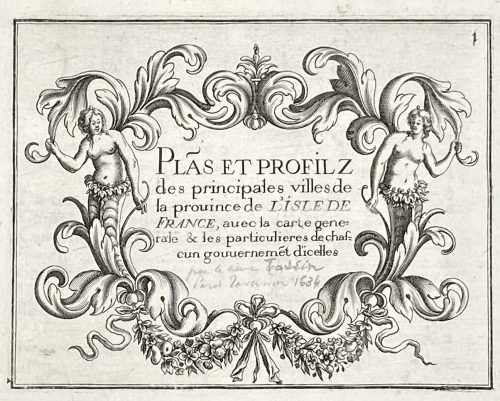 Title page: Text engraved within a vignette with two naked female torses in garlands: Plãs et profilz | des principales villes de | la prouince de L'ISLE DE | FRANCE, auec la carte gene~ | rale & les particulieres de chaf~ | cun gouuernement d'icelles. Below handwritten pencil inscription by a previous owner: "par ... Tassin ... 1634". Size: 17.6 x 23.7 cm, Binding: Italian style, green half-vellum, burgundy morocco title label with vertical gilt lettering to spine, peacock marbled boards. Pagination: Two blank flyleaves in the front and two in the back; 18 numbered engraved plates, including:
Title page: Text engraved within a vignette with two naked female torses in garlands: Plãs et profilz | des principales villes de | la prouince de L'ISLE DE | FRANCE, auec la carte gene~ | rale & les particulieres de chaf~ | cun gouuernement d'icelles. Below handwritten pencil inscription by a previous owner: "par ... Tassin ... 1634". Size: 17.6 x 23.7 cm, Binding: Italian style, green half-vellum, burgundy morocco title label with vertical gilt lettering to spine, peacock marbled boards. Pagination: Two blank flyleaves in the front and two in the back; 18 numbered engraved plates, including:- Title page
- Table of Contents
- Normandie
- Environs de Paris
- Folding map of Paris – a simplified copy of Mathieu Merian's 1615 perspective plan, with minor updates, notably on the current housing estate of Ile Saint-Louis.
- Paris
- Gouvernment de Soissons
- Soissons
- Gouvernment de Beauvais
- Beauvais
- Gouvernment de Compiègne
- Compiègne
- Gouvernment de Noyon
- Noyon
- Gouvernment de Coussi
- Coussi
- Gouvernment de Senlis
- Senlis
-
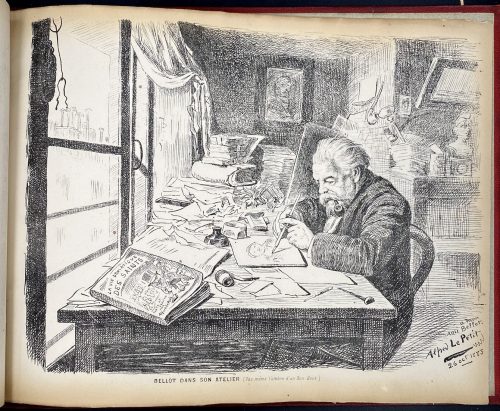 An album of the "Le Bon-Bock" dinners for the year 1884. Author, designer and publisher – Emile Bellot (French, 1831 – 1886), a Parisian artist and engraver. "Le Bon-Bock" was a monthly dinner of artists and men of letters, who gathered in Paris for good food, good company, and artistic performances, from 1875 to at least 1925. The story behind these gatherings as told by Emile Bellot, the founder, is this:
An album of the "Le Bon-Bock" dinners for the year 1884. Author, designer and publisher – Emile Bellot (French, 1831 – 1886), a Parisian artist and engraver. "Le Bon-Bock" was a monthly dinner of artists and men of letters, who gathered in Paris for good food, good company, and artistic performances, from 1875 to at least 1925. The story behind these gatherings as told by Emile Bellot, the founder, is this:In February 1875, Pierre Cottin1 came to me and said: 'I discovered a poet and tragedian of immense talent and who interprets the poems of the Great Victor Hugo in an astonishing way. Monsieur Gambini. I promised him that I would make it heard by an audience of artists and men of letters. I am counting on you who have many connections to keep my promise to him'. I gathered about 25 of my friends and acquaintances in a picnic dinner which took place at a restaurant 'Krauteimer' on the rue Rochechouart in Montmartre. They heard from Mr Gambini first, then my friends Étienne Carjat2, J. Gros3, Adrien Dézamy4, etc. performed. These gentlemen completed the evening so brilliantly that it was unanimously decided that we would start a similar dinner every month. Poets, musicians, men of letters, singers would be invited to this dinner. I was in charge of the organization of this little party and as it was the dream of my life to bring together old comrades, I was careful not to refuse and I pursued this good idea. Cottin and René Tener5 were kind enough to help me in this joyous task and especially my old friend Carjat. The following March began our 1st monthly dinner.
The name "Le Bon-Bock" means "The Good Bock", whilst Bock is a kind of beer, a dark, malty, lightly hopped ale. The dinner was named "Le Bon-Bock" in honour of the Éduard Manet painting (1873), a famous portrait of Emile Bellot, called "Le Bon-Bock".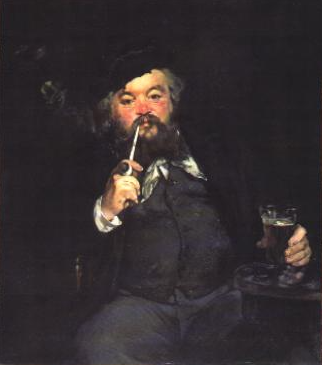 The invitations to the dinner were also produced by the artists and looked like this one by Alexandre Ferdinandus (October 3, 1883).
The invitations to the dinner were also produced by the artists and looked like this one by Alexandre Ferdinandus (October 3, 1883).
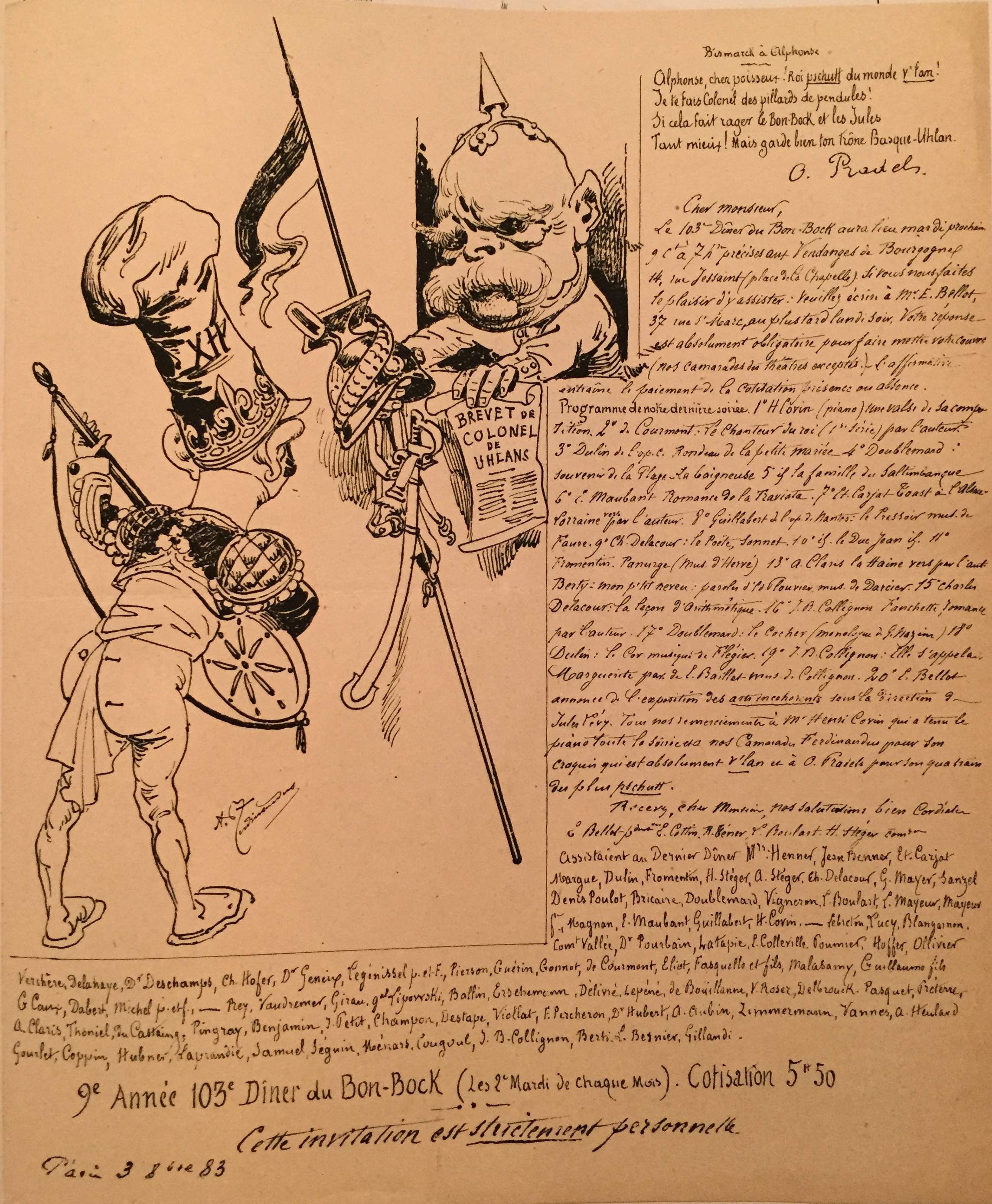 Besides this sketch of the Parisian social and artistic life at the end of the 19th century, the provenance of the album in our collection generates additional interest. The ink stamp to the front flyleaf reads: "Docteur Henry Uzan, 29 Avenue Perrichont, Paris XVI".
Doctor Henry Uzan was Jewish. He was arrested by the Pétain police on October 1, 1941, and interned in Drancy. With the few means at his disposal, he undertook to treat the sick whom he then saw leaving, week after week, towards their terrible destiny in the extermination camps. In October 1943 doctor Uzan was deported to the island of Alderney. After the Normandy Landing of June 6, 1944, Nazis evacuated the island detainees and transfer them to the Neuengamme camp, via northern France and Belgium. During the transfer, doctor Uzan managed to escape from the train on the night of September 3 to 4 around Dixmude in Flanders. He was taken in by the Belgian Resistance, which he joined before being repatriated to France.
In France, he continued working as a physician and was one of the founders of Association des internés et déportés politiques (AIDP). In 1945, together with his friends, the doctor designed the symbol for the Fédération nationale des déportés et internés résistants et patriotes:
Besides this sketch of the Parisian social and artistic life at the end of the 19th century, the provenance of the album in our collection generates additional interest. The ink stamp to the front flyleaf reads: "Docteur Henry Uzan, 29 Avenue Perrichont, Paris XVI".
Doctor Henry Uzan was Jewish. He was arrested by the Pétain police on October 1, 1941, and interned in Drancy. With the few means at his disposal, he undertook to treat the sick whom he then saw leaving, week after week, towards their terrible destiny in the extermination camps. In October 1943 doctor Uzan was deported to the island of Alderney. After the Normandy Landing of June 6, 1944, Nazis evacuated the island detainees and transfer them to the Neuengamme camp, via northern France and Belgium. During the transfer, doctor Uzan managed to escape from the train on the night of September 3 to 4 around Dixmude in Flanders. He was taken in by the Belgian Resistance, which he joined before being repatriated to France.
In France, he continued working as a physician and was one of the founders of Association des internés et déportés politiques (AIDP). In 1945, together with his friends, the doctor designed the symbol for the Fédération nationale des déportés et internés résistants et patriotes:
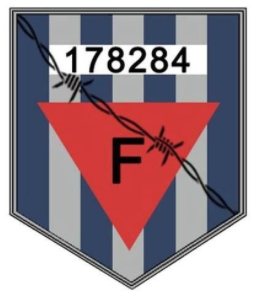 The story behind the number on the emblem (178284) is fascinating but it is out of the scope of this material.
The story behind the number on the emblem (178284) is fascinating but it is out of the scope of this material.
1. Pierre Cottin (French, 1823 – c. 1887) – Engraver, mezzotinter, genre and landscape painter; born in Chappelle-Saint-Denis (near Paris), a pupil of Jazet. Exhibited at the Salon from 1845, also in London from 1876 to 1879.↩ 2. Étienne Carjat (French, 1828 – 1906) – Journalist, caricaturist and photographer. ↩ 3. Jean Baptiste Louis Gros (French, 1793 – 1870) – Painter. ↩ 4. Adrien Dézamy (French, 1844 – 1891) – Writer, poet, general secretary of the Théâtre des Bouffes in Paris. ↩ 5. Rene Tener (French, 1846 – 1925) – Painter. ↩ Sources:Auguste Lepage. Les dîners artistiques et littéraires de Paris / Bibliothèque des Deux mondes (2e éd.) – Paris: Frinzine, Klein et Cie., 1884. [Accession № LIB-2606.2021 in this collection]
-
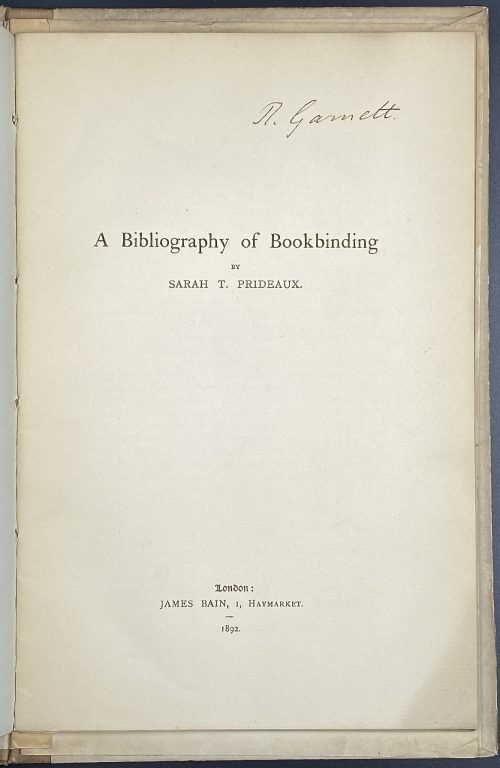 Title: A Bibliography of Bookbinding | by | SARAH T. PRIDEAUX | […] | London: | JAMES BAIN, 1 Haymarket. | 1892 || Pagination: ffl, [2] – front orig. wrapper, [2] t.p. / blank, [1] 2-23 [24] [2] back orig. wrapper. Binding: User’s quarter buckram and cardboard binding with gilt 686.P.6 number to front cover, 686 P to front wrapper, ink inscription T. Garnett (possibly Garnett & Co, Printers of Manchester Guardian) to t.p., blue ink stamp of Manchester P. F. libraries, pencilled 686 P6 to t.p. verso. To front pastedown an armorial bookplate of the Manchester public free libraries. and pasted Class No. R686 P6. Blueish original wrappers preserved.
Title: A Bibliography of Bookbinding | by | SARAH T. PRIDEAUX | […] | London: | JAMES BAIN, 1 Haymarket. | 1892 || Pagination: ffl, [2] – front orig. wrapper, [2] t.p. / blank, [1] 2-23 [24] [2] back orig. wrapper. Binding: User’s quarter buckram and cardboard binding with gilt 686.P.6 number to front cover, 686 P to front wrapper, ink inscription T. Garnett (possibly Garnett & Co, Printers of Manchester Guardian) to t.p., blue ink stamp of Manchester P. F. libraries, pencilled 686 P6 to t.p. verso. To front pastedown an armorial bookplate of the Manchester public free libraries. and pasted Class No. R686 P6. Blueish original wrappers preserved. -
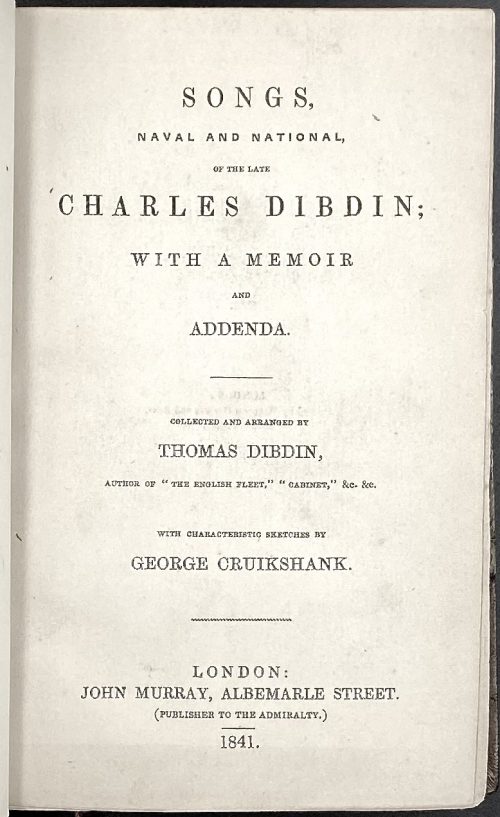 Title: SONGS, | NAVAL AND NATIONAL, | OF THE LATE | CHARLES DIBDIN; | WITH A MEMOIR | AND | ADDENDA. | COLLECTED AND ARRANGED BY | THOMAS DIBDIN, | AUTHOR OF “THE ENGLISH FLEET,” CABINET,” &c. &c. | WITH CHARACTERISTIC SKETCHES BY | GEORGE CRUIKSHANK. | LONDON: | JOHN MURRAY, ALBEMARLE STREET. | (PUBLISHED TO THE ADMIRALTY) | 1841.|| Pagination: [4 binder's blanks] [i-vi] vii-xv [xvi advert.], [1] 2-336 [4 binder's blanks], engraved frontispiece and 11 plates by George Cruikshank. Collation: 8vo; [A] – Y8. Binding: brown ¾ morocco, ruled in gilt over marbled boards, marbled endpapers, raised bands, gilt in compartments, top margin gilt, title lettering and year to spine, by V. Krafft. Bookplate to front pastedown “Ex Libris Robert Hoe”. Provenance: HOE, Robert III (American, 1839-1909) – American businessman and producer of printing press equipment. Catalogue raisonné: Albert M. Cohn (1924): № 231, p. 75. Makers: Charles Dibdin the younger (British, 1768—1833) – author. Thomas John Dibdin (British, 1771—1841) – author. William Clowes (British, 1779—1847), printer. John Murray III (British, 1808—1892), publisher. George Cruikshank (British, 1792—1878), artist, emgraver.
Title: SONGS, | NAVAL AND NATIONAL, | OF THE LATE | CHARLES DIBDIN; | WITH A MEMOIR | AND | ADDENDA. | COLLECTED AND ARRANGED BY | THOMAS DIBDIN, | AUTHOR OF “THE ENGLISH FLEET,” CABINET,” &c. &c. | WITH CHARACTERISTIC SKETCHES BY | GEORGE CRUIKSHANK. | LONDON: | JOHN MURRAY, ALBEMARLE STREET. | (PUBLISHED TO THE ADMIRALTY) | 1841.|| Pagination: [4 binder's blanks] [i-vi] vii-xv [xvi advert.], [1] 2-336 [4 binder's blanks], engraved frontispiece and 11 plates by George Cruikshank. Collation: 8vo; [A] – Y8. Binding: brown ¾ morocco, ruled in gilt over marbled boards, marbled endpapers, raised bands, gilt in compartments, top margin gilt, title lettering and year to spine, by V. Krafft. Bookplate to front pastedown “Ex Libris Robert Hoe”. Provenance: HOE, Robert III (American, 1839-1909) – American businessman and producer of printing press equipment. Catalogue raisonné: Albert M. Cohn (1924): № 231, p. 75. Makers: Charles Dibdin the younger (British, 1768—1833) – author. Thomas John Dibdin (British, 1771—1841) – author. William Clowes (British, 1779—1847), printer. John Murray III (British, 1808—1892), publisher. George Cruikshank (British, 1792—1878), artist, emgraver. -
 Title: MEMOIRS OF M. THIERS | 1870—1873 | Translated by | F. M. ATKINSON | {publisher’s device} | LONDON: GEORGE ALLEN & UNWIN LTD. | RUSKIN HOUSE 40 MUSEUM STREET, W.C. Pagination: [6] 7-384. Collation: 8vo; [1]-248. Size: 23 x 15 cm Binding: Blue cloth, top and bottom ruled in blind, gilt lettering to front cover and spine. Original: Adolphe Thiers. Notes et souvenirs de M. Thiers, 1870-1873: voyage diplomatique, proposition d'un armistice, préliminaires de la paix, présidence de la République. — Paris : [s.n.], 1901. — 465 p. The preface and editing signed "F. D." [Félicie Dosne]. Félicie Dosne (French, 1823 – 1906) was Thiers's sister-in-law.
Title: MEMOIRS OF M. THIERS | 1870—1873 | Translated by | F. M. ATKINSON | {publisher’s device} | LONDON: GEORGE ALLEN & UNWIN LTD. | RUSKIN HOUSE 40 MUSEUM STREET, W.C. Pagination: [6] 7-384. Collation: 8vo; [1]-248. Size: 23 x 15 cm Binding: Blue cloth, top and bottom ruled in blind, gilt lettering to front cover and spine. Original: Adolphe Thiers. Notes et souvenirs de M. Thiers, 1870-1873: voyage diplomatique, proposition d'un armistice, préliminaires de la paix, présidence de la République. — Paris : [s.n.], 1901. — 465 p. The preface and editing signed "F. D." [Félicie Dosne]. Félicie Dosne (French, 1823 – 1906) was Thiers's sister-in-law. -
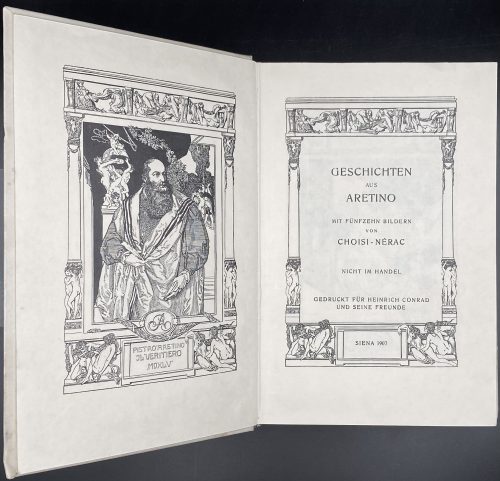 Title: GESCHICHTEN | AUS | ARETINO | MIT FÜNFZEHN BILDERN | VON | CHOISI-NÉRAC | NICHT IM HANDEL | GEDRUCKT FÜR HEINRICH CONRAD | UND SEINE FREUNDE | SIENA 1907 || Collation: 8vo; 1-128 137; frontispiece, t.p. and 14 plates, extraneous to collation. Pagination: [2] f.t. / blank, 3-203 [2], il. Binding: Full cream vellum, ruled with gilt double-fillet, grey label with gilt lettering to spine. Bookplate by von Bayros Par Avi Cigno to front pastedown. Note: Private edition of Aretino's Ragionamenti in German as Geschichten aus Aretino by translater and publisher Heinrich Conrad (German, 1866 – 1918), whose real name was Hugo Storm, this copy №394, illustrated by Franz von Bayros (Austrian, 1866 – of Choisi-Nérac.
Title: GESCHICHTEN | AUS | ARETINO | MIT FÜNFZEHN BILDERN | VON | CHOISI-NÉRAC | NICHT IM HANDEL | GEDRUCKT FÜR HEINRICH CONRAD | UND SEINE FREUNDE | SIENA 1907 || Collation: 8vo; 1-128 137; frontispiece, t.p. and 14 plates, extraneous to collation. Pagination: [2] f.t. / blank, 3-203 [2], il. Binding: Full cream vellum, ruled with gilt double-fillet, grey label with gilt lettering to spine. Bookplate by von Bayros Par Avi Cigno to front pastedown. Note: Private edition of Aretino's Ragionamenti in German as Geschichten aus Aretino by translater and publisher Heinrich Conrad (German, 1866 – 1918), whose real name was Hugo Storm, this copy №394, illustrated by Franz von Bayros (Austrian, 1866 – of Choisi-Nérac. -
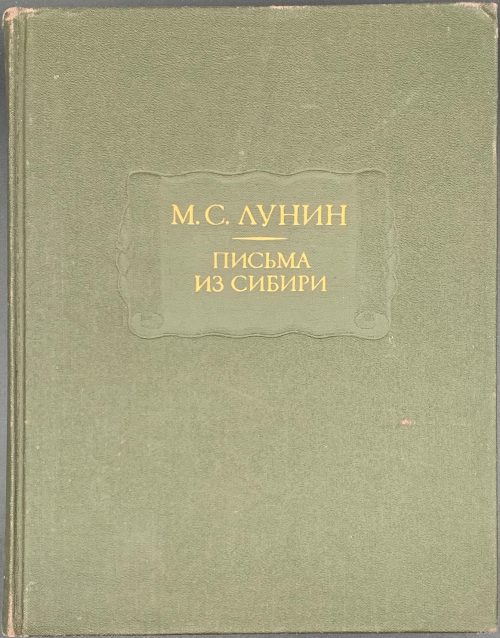 Title (black and red): М. С. ЛУНИН | — | ПИСЬМА ИЗ СИБИРИ | — | Издание подготовили | И. А. Желвакова и Н. Я Эйдельман | МОСКВА | «НАУКА» | 1987 || Pagination: [1, 2] Serial h.t. / blank, [3, 4] t.p. / imprint, [5] 6-492 [4], 1 portrait and 8 leaves of plates. Collation: 16mo; [1]16 216 38 (plates), 4-1716. Binding: serial green buckram blind-stamped with a scroll adorned with gold lettering to board and spine.
Title (black and red): М. С. ЛУНИН | — | ПИСЬМА ИЗ СИБИРИ | — | Издание подготовили | И. А. Желвакова и Н. Я Эйдельман | МОСКВА | «НАУКА» | 1987 || Pagination: [1, 2] Serial h.t. / blank, [3, 4] t.p. / imprint, [5] 6-492 [4], 1 portrait and 8 leaves of plates. Collation: 16mo; [1]16 216 38 (plates), 4-1716. Binding: serial green buckram blind-stamped with a scroll adorned with gold lettering to board and spine. -
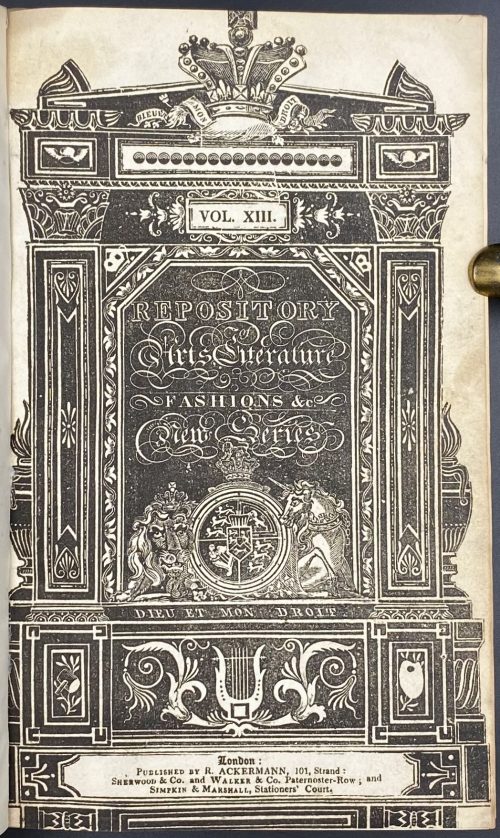 Pagination: [2] – letterpress title / blank, t.p. with contents / to readers, [1] 2-376 + 7 b/w and 16 coloured plates (total 23); this differs to Abbey’s description of 372 pages + 4 pages index, and 41 plates (lacking 18 plates). In No 73 lacking 3 plates: Quadrant Regent st., Morning dress and Full dress. In No 74 lacking 5 plates: Charles str., Brienz, head dresses, full dress, and muslin patterns. In No 75 lacking 5 plates: 4 with bank notes and Castle of Rinkenberg. In No 76 lacking 1 plate: Cavern St. Beat. In No 77 lacking 2 plates: Wetzar and Lake Thun. In No 78 lacking 2 plates: Crescent at Portland Place and Environs of Thun. Collation: 4to; letterpress title, [A]1 B-Z4 Aa-Zz4 3A-3C4 3D2. Binding: 23.5 x 15.5 cm; double fillet blind-ruled half-calf over pebbled cloth boards, raised bands ruled blind, crimson label with gilt lettering to spine. References: Martin Hardie (1906), p.310 [LIB-2623.2021]; R. V. Tooley (1935), p. 26 [LIB-2641.2021]; J. R. Abbey (1953), Cat. № 212, p. 174 [LIB-2622.2021].
Pagination: [2] – letterpress title / blank, t.p. with contents / to readers, [1] 2-376 + 7 b/w and 16 coloured plates (total 23); this differs to Abbey’s description of 372 pages + 4 pages index, and 41 plates (lacking 18 plates). In No 73 lacking 3 plates: Quadrant Regent st., Morning dress and Full dress. In No 74 lacking 5 plates: Charles str., Brienz, head dresses, full dress, and muslin patterns. In No 75 lacking 5 plates: 4 with bank notes and Castle of Rinkenberg. In No 76 lacking 1 plate: Cavern St. Beat. In No 77 lacking 2 plates: Wetzar and Lake Thun. In No 78 lacking 2 plates: Crescent at Portland Place and Environs of Thun. Collation: 4to; letterpress title, [A]1 B-Z4 Aa-Zz4 3A-3C4 3D2. Binding: 23.5 x 15.5 cm; double fillet blind-ruled half-calf over pebbled cloth boards, raised bands ruled blind, crimson label with gilt lettering to spine. References: Martin Hardie (1906), p.310 [LIB-2623.2021]; R. V. Tooley (1935), p. 26 [LIB-2641.2021]; J. R. Abbey (1953), Cat. № 212, p. 174 [LIB-2622.2021]. -
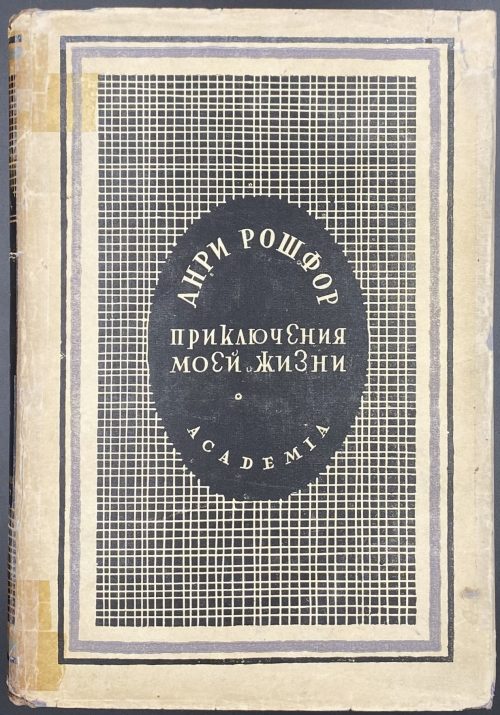 Title (in black and red): АНРИ РОШФОР | ПРИКЛЮЧЕНИЯ МОЕЙ ЖИЗНИ | ПЕРЕВОД, ВСТУПИТЕЛЬНАЯ | СТАТЬЯ И ПРИМЕЧАНИЯ | Е. СМИРНОВА | ACADEMIA | 1933 || Opposite title: ИНОСТРАННЫЕ МЕМУАРЫ, ДНЕВНИКИ, | ПИСЬМА И МАТЕРИАЛЫ | Под редакцией И. Т. Смилги ( whited-out) | АНРИ РОШФОР | 1831—1913 | ACADEMIA | МОСКВА — ЛЕНИНГРАД || Title verso: Henri Rochefort | Les Aventures de ma vie. | Переплет и суперобложка | по рисункам М. В. Ушакова-Поскочина. Pagination: [1, 2] – publisher’s device / blank, [3, 4] – opposite title, [5, 6] – t.p. / orig. title, 7-452 [453-460], ill. Collation: [1]-288 296 + 15 plates extraneous to collation. Binding: burgundy cloth ruled blind and stamped in gilt with a lantern to cover and lettering to spine, pictorial DJ; top margin red. Catalogue raisonné: Крылов, Е. В. Кичатова. "Academia" (2004): p. 237-8. Ушаков [Ушаков-Поскочин], Максим Владимирович (Russian, 1893 – 1943) – died in NKVD labor camp. Смилга, Ивар Тенисович (Latvian-Russian, 1892 – 1937) — shot dead by NKVD firing squad.
Title (in black and red): АНРИ РОШФОР | ПРИКЛЮЧЕНИЯ МОЕЙ ЖИЗНИ | ПЕРЕВОД, ВСТУПИТЕЛЬНАЯ | СТАТЬЯ И ПРИМЕЧАНИЯ | Е. СМИРНОВА | ACADEMIA | 1933 || Opposite title: ИНОСТРАННЫЕ МЕМУАРЫ, ДНЕВНИКИ, | ПИСЬМА И МАТЕРИАЛЫ | Под редакцией И. Т. Смилги ( whited-out) | АНРИ РОШФОР | 1831—1913 | ACADEMIA | МОСКВА — ЛЕНИНГРАД || Title verso: Henri Rochefort | Les Aventures de ma vie. | Переплет и суперобложка | по рисункам М. В. Ушакова-Поскочина. Pagination: [1, 2] – publisher’s device / blank, [3, 4] – opposite title, [5, 6] – t.p. / orig. title, 7-452 [453-460], ill. Collation: [1]-288 296 + 15 plates extraneous to collation. Binding: burgundy cloth ruled blind and stamped in gilt with a lantern to cover and lettering to spine, pictorial DJ; top margin red. Catalogue raisonné: Крылов, Е. В. Кичатова. "Academia" (2004): p. 237-8. Ушаков [Ушаков-Поскочин], Максим Владимирович (Russian, 1893 – 1943) – died in NKVD labor camp. Смилга, Ивар Тенисович (Latvian-Russian, 1892 – 1937) — shot dead by NKVD firing squad. -
![Insel-Almanach auf das Jahr 1907. Kalender für 1907. (with illustration by Franz von Bayros on p. 50). — 150 + [2] pp.](https://varshavskycollection.com/wp-content/uploads/2021/02/LIB-2250.2019-a-500x858.jpeg) Half-title: ÜBERREICHT VON | GILHOFER UND RANSCHBURG | SORTIMENT–, BÜCHER– UND KUNST– | ANTIQUARIAT | WIEN 1, BOGNERGASSE 2 || Title: Red letterpress lettering in black ornamental frame: Insel- | Almanach | auf das Jahr | 1907 || Pagination: [6] – h.t., frontis., title; [1-16] 17-150 [2], + 2 folding plates (op. p. 30 and 32), and 2 plates op. p. 50 (Franz von Bayros "Francine" for Die Bohème by Henri Murger) and 112 (colour). Binding: 17.3 x 9.9 cm; original olive paper wrappers with gilt lettering and elements to cover, lettering to spine. Catalogue raisonné: Heinz Sarkowski (1999): № 1986, pp. 329-30, with contents. Contributors: Gilhofer und Ranschburg – antiquarian bookstore in Vienna. Schröder, Rudolf Alexander (German, 1878 – 1962) – title and cover. Wieynk, Heinrich (German, 1874 – 1931) – typeset. Kippenberg, Anton Hermann Friedrich (German, 1874 – 1950) – editor. Brandstetter, Oscar (German, 1844 – ?) – printer.
Half-title: ÜBERREICHT VON | GILHOFER UND RANSCHBURG | SORTIMENT–, BÜCHER– UND KUNST– | ANTIQUARIAT | WIEN 1, BOGNERGASSE 2 || Title: Red letterpress lettering in black ornamental frame: Insel- | Almanach | auf das Jahr | 1907 || Pagination: [6] – h.t., frontis., title; [1-16] 17-150 [2], + 2 folding plates (op. p. 30 and 32), and 2 plates op. p. 50 (Franz von Bayros "Francine" for Die Bohème by Henri Murger) and 112 (colour). Binding: 17.3 x 9.9 cm; original olive paper wrappers with gilt lettering and elements to cover, lettering to spine. Catalogue raisonné: Heinz Sarkowski (1999): № 1986, pp. 329-30, with contents. Contributors: Gilhofer und Ranschburg – antiquarian bookstore in Vienna. Schröder, Rudolf Alexander (German, 1878 – 1962) – title and cover. Wieynk, Heinrich (German, 1874 – 1931) – typeset. Kippenberg, Anton Hermann Friedrich (German, 1874 – 1950) – editor. Brandstetter, Oscar (German, 1844 – ?) – printer. -
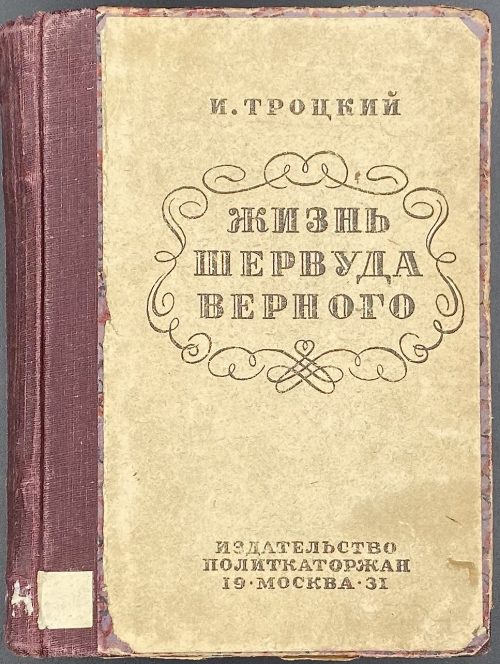 Front cover: И. ТРОЦКИЙ | ЖИЗНЬ | ШЕРВУДА | ВЕРНОГО | ИЗДАТЕЛЬСТВО | ПОЛИТКАТОРЖАН | 19 • МОСКВА • 31 || Title page: И. М. ТРОЦКИЙ | ЖИЗНЬ | ШЕРВУДА – ВЕРНОГО | (ОЧЕРКИ И МАТЕРИАЛЫ) | ИЗДАТЕЛЬСТВО ВСЕСОЮЗНОГО ОБЩЕСТВА ПОЛИТКАТОРЖАН И ССЫЛЬНО-ПОСЕЛЕНЦЕВ |1 9 МОСКВА 3 1 || Pagination: [1-4] 5-277 [3]. Collation: 8vo; [1]8 2-178, 184. Binding: Quarter burgundy cloth, paper over cardboard. Library ‘pocket’ to front pastedown. Inscriptions and marks: Inscription to t.p. in purple ink: «323.2/П76»; stamp in purple ink “193” and “3” handwritten; black in stamp “1935”; purple ink oval stamp: «БИБЛИОТЕКА * МОСК. ХУДОЖ. ТЕАТРА *», inside handwritten: 3703; same stamp at p. 278. Print run: 5,000 copies. Contributor: Исаак Моисеевич Троцкий (Russian-Jewish, 1903 – 1937) – author of the text.
Front cover: И. ТРОЦКИЙ | ЖИЗНЬ | ШЕРВУДА | ВЕРНОГО | ИЗДАТЕЛЬСТВО | ПОЛИТКАТОРЖАН | 19 • МОСКВА • 31 || Title page: И. М. ТРОЦКИЙ | ЖИЗНЬ | ШЕРВУДА – ВЕРНОГО | (ОЧЕРКИ И МАТЕРИАЛЫ) | ИЗДАТЕЛЬСТВО ВСЕСОЮЗНОГО ОБЩЕСТВА ПОЛИТКАТОРЖАН И ССЫЛЬНО-ПОСЕЛЕНЦЕВ |1 9 МОСКВА 3 1 || Pagination: [1-4] 5-277 [3]. Collation: 8vo; [1]8 2-178, 184. Binding: Quarter burgundy cloth, paper over cardboard. Library ‘pocket’ to front pastedown. Inscriptions and marks: Inscription to t.p. in purple ink: «323.2/П76»; stamp in purple ink “193” and “3” handwritten; black in stamp “1935”; purple ink oval stamp: «БИБЛИОТЕКА * МОСК. ХУДОЖ. ТЕАТРА *», inside handwritten: 3703; same stamp at p. 278. Print run: 5,000 copies. Contributor: Исаак Моисеевич Троцкий (Russian-Jewish, 1903 – 1937) – author of the text. -
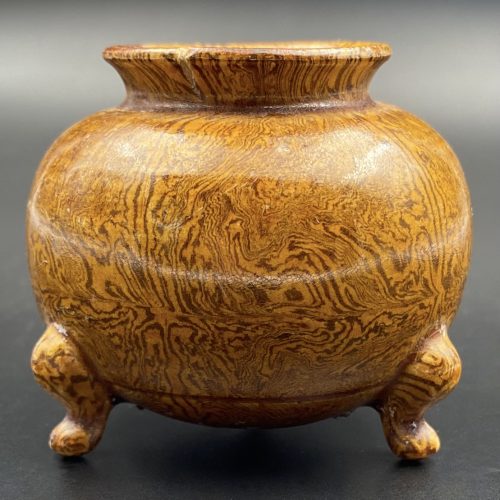 Small amber-glazed marbled (Jiaotai) pottery tripod censer. Inside the glaze is monochrome because the clay itself is not marbled. Spur marks on the bottom. Small chip on a lip. China, Henan province, the Tang dynasty [唐朝] (618 – 907). Diameter: 6.3 cm; Height: 5.5 cm.
Small amber-glazed marbled (Jiaotai) pottery tripod censer. Inside the glaze is monochrome because the clay itself is not marbled. Spur marks on the bottom. Small chip on a lip. China, Henan province, the Tang dynasty [唐朝] (618 – 907). Diameter: 6.3 cm; Height: 5.5 cm. -
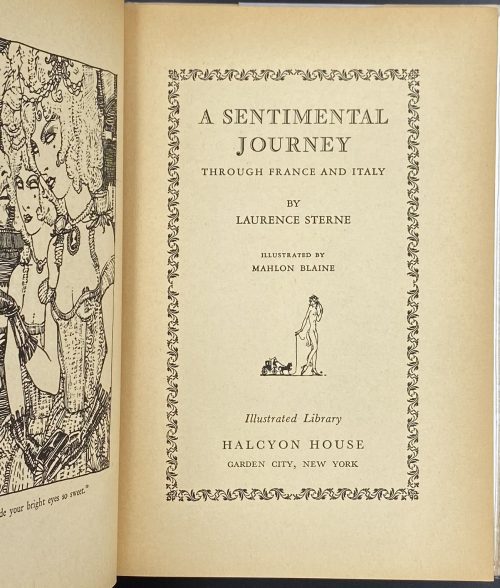 Title: A SENTIMENTAL | JOURNEY | THROUGH FRANCE AND ITALY | BY | LAURENCE STERNE | ILLUSTRATED BY | MAHLON BLAINE | {vignette} | Illustrated library | HALCYON HOUSE | GARDEN CITY, NEW YORK || Pagination: [1-6] – first leaf blank, h.t., t.p., 7-192, total 192 pages; frontispiece plus 4 plates within collation, and a headpiece, all photomechanical reproductions of Mahlon Blaine’s pen drawings. Binding: 20.5 x 14 cm, off-white pictorial paper boards decorated with black ivy-clad pink lattice, black lettering in a pink frame to spine, pink pictorial dust jacket with spine sunned to beige. Contributors: Sterne, Laurence (British-Irish, 1713 – 1768) – author of the text. Blaine, Mahlon (American, 1894 – 1969) – illustrator (pseudonym: G. Christopher Hudson). The Illustrated library series was started by Halcyon House, a reprint division of Doubleday Publishers, in 1950. This edition of Sterne with Blaine’s illustrations is a reprint of the same, published by Three Sirens Press of New York in 1930. Blaine's illustrations of this kind are pen drawings, not wood engravings.
Title: A SENTIMENTAL | JOURNEY | THROUGH FRANCE AND ITALY | BY | LAURENCE STERNE | ILLUSTRATED BY | MAHLON BLAINE | {vignette} | Illustrated library | HALCYON HOUSE | GARDEN CITY, NEW YORK || Pagination: [1-6] – first leaf blank, h.t., t.p., 7-192, total 192 pages; frontispiece plus 4 plates within collation, and a headpiece, all photomechanical reproductions of Mahlon Blaine’s pen drawings. Binding: 20.5 x 14 cm, off-white pictorial paper boards decorated with black ivy-clad pink lattice, black lettering in a pink frame to spine, pink pictorial dust jacket with spine sunned to beige. Contributors: Sterne, Laurence (British-Irish, 1713 – 1768) – author of the text. Blaine, Mahlon (American, 1894 – 1969) – illustrator (pseudonym: G. Christopher Hudson). The Illustrated library series was started by Halcyon House, a reprint division of Doubleday Publishers, in 1950. This edition of Sterne with Blaine’s illustrations is a reprint of the same, published by Three Sirens Press of New York in 1930. Blaine's illustrations of this kind are pen drawings, not wood engravings. -
![Gordon N. Ray. The Art of the French Illustrated Book 1700 to 1914 (2 vol. set). — NY, London: The Pierpont Morgan Library; Cornell University Press, 1982. — pp.: vol.1: [8] ix-xxxii, [2] 3-245 [3]; vol.2: [8] 247-557 [5], illustr.](https://varshavskycollection.com/wp-content/uploads/2021/02/LIB-2424.2020-500x2190.jpeg) Title page: The Art of the | French Illustrated Book | 1700 to 1914 | VOLUME I (II) | Gordon N. Ray | The Pierpont Morgan Library | Cornell University Press || Pagination: vol.1: [8] ix-xxxii, [2] 3-245 [3], illustr.; vol.2: [8] 247-557 [5], illustr. Both volumes paginater through out. Binding: 30.5 x 23.5 cm, two volumes uniformly bound in red cloth, gilt vignette to front cover, gilt lettering to spine; bookplate to front pastedown, ex-lib (Sweet Briar College Library) Contributors: Ray, Gordon Norton (American, 1915 – 1986) – author. Lange, Thomas V. – formal bibliographical description. Passela, Charles V. – photography. The Pierpont Morgan Library – Copyright © 1982
Title page: The Art of the | French Illustrated Book | 1700 to 1914 | VOLUME I (II) | Gordon N. Ray | The Pierpont Morgan Library | Cornell University Press || Pagination: vol.1: [8] ix-xxxii, [2] 3-245 [3], illustr.; vol.2: [8] 247-557 [5], illustr. Both volumes paginater through out. Binding: 30.5 x 23.5 cm, two volumes uniformly bound in red cloth, gilt vignette to front cover, gilt lettering to spine; bookplate to front pastedown, ex-lib (Sweet Briar College Library) Contributors: Ray, Gordon Norton (American, 1915 – 1986) – author. Lange, Thomas V. – formal bibliographical description. Passela, Charles V. – photography. The Pierpont Morgan Library – Copyright © 1982 -
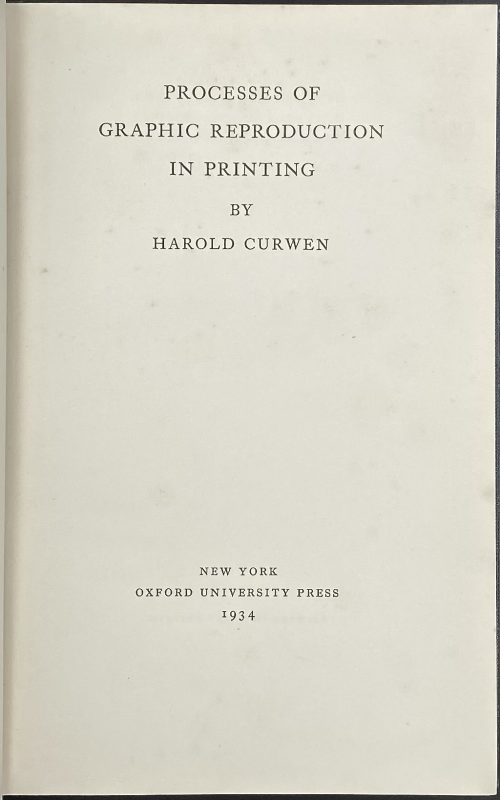 Title: PROCESSES OF | GRAPHIC REPRODUCTION | IN PRINTING | BY | HAROLD CURWEN | [space] | NEW YORK | OXFORD UNIVERSITY PRESS | 1934 || Pagination: [i-vii] viii-xvi [6] [1-3] 4-142 [2], ills. Collation: 8vo; π3 [A]8 B-K8, 14 plates extraneous to collation, in-text illustrations. Binding: 22.5 x 15.5 cm, dark-blue cloth, remnants of gilt lettering to spine. Edition: 2nd (after the 1st published by Faber and Faber in London, printed by The Curwen Press in Plaistow, the same year, 1934 – [LIB-2840.2021]). Contributors: Harold Curwen (British, 1885 – 1949), grandson of John Curwen (British, 1816 – 1880) The Curwen Press (Plaistow, London) – printer.
Title: PROCESSES OF | GRAPHIC REPRODUCTION | IN PRINTING | BY | HAROLD CURWEN | [space] | NEW YORK | OXFORD UNIVERSITY PRESS | 1934 || Pagination: [i-vii] viii-xvi [6] [1-3] 4-142 [2], ills. Collation: 8vo; π3 [A]8 B-K8, 14 plates extraneous to collation, in-text illustrations. Binding: 22.5 x 15.5 cm, dark-blue cloth, remnants of gilt lettering to spine. Edition: 2nd (after the 1st published by Faber and Faber in London, printed by The Curwen Press in Plaistow, the same year, 1934 – [LIB-2840.2021]). Contributors: Harold Curwen (British, 1885 – 1949), grandson of John Curwen (British, 1816 – 1880) The Curwen Press (Plaistow, London) – printer.


